
Support our hydrofoil educational content for free when you purchase through links on our site. Learn more

[2023] Hydrofoil Catamaran: The Ultimate Guide to Foiling on Water
- November 1, 2023
- Hydrofoil Basics
Experience the thrill of flying above the water with a hydrofoil catamaran!
Are you ready to take your hydrofoil boarding to the next level? Look no further than the hydrofoil catamaran. In this comprehensive guide, we’ll dive deep into the world of hydrofoil catamarans, exploring their history, how they work, their benefits and drawbacks, and everything else you need to know to make an informed decision. So, buckle up and get ready to soar above the waves!
Table of Contents
Quick answer, quick tips and facts, how does a hydrofoil catamaran work, benefits of hydrofoil catamarans, drawbacks of hydrofoil catamarans, choosing the right hydrofoil catamaran, maintenance and care, recommended links, reference links.
A hydrofoil catamaran is a type of watercraft that combines the stability of a catamaran with the lift and speed of hydrofoils. It uses specially designed foils to lift the hulls out of the water, reducing drag and allowing for faster and smoother sailing. Hydrofoil catamarans are popular among sailors and water sports enthusiasts for their incredible speed, maneuverability, and thrilling foiling experience.
Shopping Links: Hydrofoil Catamarans on Amazon | Hydrofoil Catamarans on Walmart | Hydrofoil Catamarans on Etsy
- Hydrofoil catamarans can reach speeds of up to 40 knots (46 mph) or more, depending on the design and conditions.
- The foils on a hydrofoil catamaran can lift the hulls out of the water, reducing drag and allowing for a smoother and faster ride.
- Hydrofoil catamarans are used for various purposes, including racing, recreational sailing, and even transportation.
- Foiling on a hydrofoil catamaran requires some skill and practice, but it’s an exhilarating experience once you get the hang of it.
- Hydrofoil catamarans come in different sizes and designs, catering to different skill levels and preferences.
Hydrofoil catamarans have a fascinating history that dates back to the early 20th century. The concept of using hydrofoils to lift boats out of the water and reduce drag was first explored by Italian engineer Enrico Forlanini in the late 1800s. However, it wasn’t until the 1950s that hydrofoil technology started to gain traction in the boating world.
The first hydrofoil catamaran, known as the “Aquavion,” was developed by the French engineer René Guilbaud in the 1950s. This innovative design combined the stability of a catamaran with the lift of hydrofoils, revolutionizing the world of sailing. Since then, hydrofoil catamarans have evolved and become more advanced, offering incredible speed, maneuverability, and stability on the water.
A hydrofoil catamaran works by utilizing hydrofoils, which are wing-like structures mounted underneath the hulls of the boat. These foils generate lift as the boat gains speed, lifting the hulls out of the water and reducing drag. This lift allows the hydrofoil catamaran to achieve higher speeds and a smoother ride compared to traditional boats.
The hydrofoils on a catamaran are typically designed with a curved shape, similar to an airplane wing. This shape creates a pressure difference between the upper and lower surfaces of the foil, generating lift. The foils are usually adjustable, allowing the sailor to fine-tune the performance of the catamaran based on the sailing conditions.
To control the hydrofoil catamaran, sailors use a combination of steering and sail trim. By adjusting the angle of the foils and the sails, they can optimize the lift and balance of the boat, ensuring a stable and efficient ride. It takes some practice to master the art of foiling on a hydrofoil catamaran, but the rewards are well worth the effort.
Hydrofoil catamarans offer a range of benefits that make them a popular choice among sailors and water sports enthusiasts. Here are some of the key advantages of hydrofoil catamarans:
Speed : Hydrofoil catamarans are known for their incredible speed. By lifting the hulls out of the water, hydrofoils reduce drag and allow the boat to glide smoothly above the waves. This enables hydrofoil catamarans to reach impressive speeds, making them a thrilling choice for racing and high-performance sailing.
Maneuverability : The lift generated by hydrofoils enhances the maneuverability of catamarans. With reduced drag, hydrofoil catamarans can make sharp turns and quick maneuvers with ease. This agility is particularly useful in racing scenarios, where every second counts.
Stability : The dual-hull design of catamarans provides inherent stability, even at high speeds. When combined with hydrofoils, the stability of hydrofoil catamarans is further enhanced. This stability makes them suitable for sailors of all skill levels, from beginners to experienced professionals.
Efficiency : Hydrofoil catamarans are more efficient than traditional boats. By reducing drag, hydrofoils allow the boat to sail faster while using less power. This increased efficiency translates to longer sailing distances and reduced fuel consumption, making hydrofoil catamarans an environmentally friendly choice.
Versatility : Hydrofoil catamarans are versatile watercraft that can be used for various purposes. Whether you’re looking for a high-performance racing catamaran or a recreational sailboat for family outings, there’s a hydrofoil catamaran to suit your needs. Some models even offer the option to switch between foiling and non-foiling modes, providing flexibility on the water.
While hydrofoil catamarans offer numerous benefits, it’s important to consider their drawbacks as well. Here are a few potential downsides to keep in mind:
Cost : Hydrofoil catamarans tend to be more expensive than traditional boats. The advanced technology and materials used in their construction contribute to the higher price tag. Additionally, maintenance and repairs can also be costly, especially if specialized parts or services are required.
Learning Curve : Foiling on a hydrofoil catamaran requires some skill and practice. It can take time to learn how to control the boat effectively and maintain stability while flying above the water. Beginners may find the learning curve steep, but with dedication and proper instruction, anyone can master the art of hydrofoil catamaran sailing.
Weather Conditions : Hydrofoil catamarans are sensitive to weather conditions. While they excel in flat water and moderate winds, rough seas and strong gusts can pose challenges. It’s important to be aware of the weather forecast and choose suitable sailing conditions to ensure a safe and enjoyable experience.
Transportation and Storage : Hydrofoil catamarans can be larger and bulkier than traditional boats, making transportation and storage more challenging. Specialized trailers or racks may be required to transport the catamaran, and adequate storage space is needed to protect it when not in use.
Despite these drawbacks, the thrill and excitement of foiling on a hydrofoil catamaran outweigh the challenges for many sailing enthusiasts.
When it comes to choosing the right hydrofoil catamaran, there are several factors to consider. Here are some key points to keep in mind:
Skill Level : Consider your skill level and experience as a sailor. Some hydrofoil catamarans are designed for advanced sailors, while others are more beginner-friendly. Choose a catamaran that matches your skill level to ensure a safe and enjoyable sailing experience.
Intended Use : Determine how you plan to use the hydrofoil catamaran. Are you looking for a racing catamaran, a recreational sailboat, or something in between? Different models offer varying features and performance characteristics, so it’s essential to choose a catamaran that aligns with your intended use.
Budget : Set a budget for your hydrofoil catamaran purchase. Prices can vary significantly depending on the brand, model, and features. Consider both the upfront cost and the long-term maintenance expenses when determining your budget.
Brand and Reputation : Research different brands and their reputation in the hydrofoil catamaran industry. Look for brands with a track record of producing high-quality, reliable catamarans. Reading customer reviews and seeking recommendations from experienced sailors can also provide valuable insights.
Demo and Test Sails : Whenever possible, try out different hydrofoil catamarans before making a final decision. Many manufacturers and dealers offer demo and test sails, allowing you to experience the performance and handling of the catamaran firsthand. This hands-on experience can help you make an informed choice.
Remember, choosing the right hydrofoil catamaran is a personal decision that depends on your individual preferences and needs. Take your time, do your research, and consult with experts to find the perfect catamaran for your hydrofoil adventures.
Proper maintenance and care are essential to keep your hydrofoil catamaran in top shape and ensure its longevity. Here are some maintenance tips to help you keep your catamaran performing at its best:
Rinse with Fresh Water : After each sailing session, rinse your hydrofoil catamaran with fresh water to remove salt and debris. Pay special attention to the foils, as saltwater can cause corrosion over time.
Inspect for Damage : Regularly inspect your catamaran for any signs of damage or wear. Check the foils, hulls, rigging, and sails for any cracks, dents, or loose fittings. Address any issues promptly to prevent further damage.
Store Properly : When not in use, store your hydrofoil catamaran in a dry and secure location. If possible, keep it covered to protect it from the elements. Consider using a boat cover or storing it in a boat shed or garage.
Follow Manufacturer’s Guidelines : Follow the manufacturer’s guidelines for maintenance and care. Each catamaran may have specific recommendations for cleaning, lubrication, and other maintenance tasks. Adhering to these guidelines will help prolong the life of your catamaran.
Seek Professional Assistance : If you’re unsure about any maintenance tasks or need assistance, don’t hesitate to seek professional help. Local boatyards, sailing clubs, or authorized dealers can provide expert advice and services to keep your catamaran in optimal condition.
By following these maintenance tips and caring for your hydrofoil catamaran, you can enjoy many years of thrilling foiling adventures on the water.
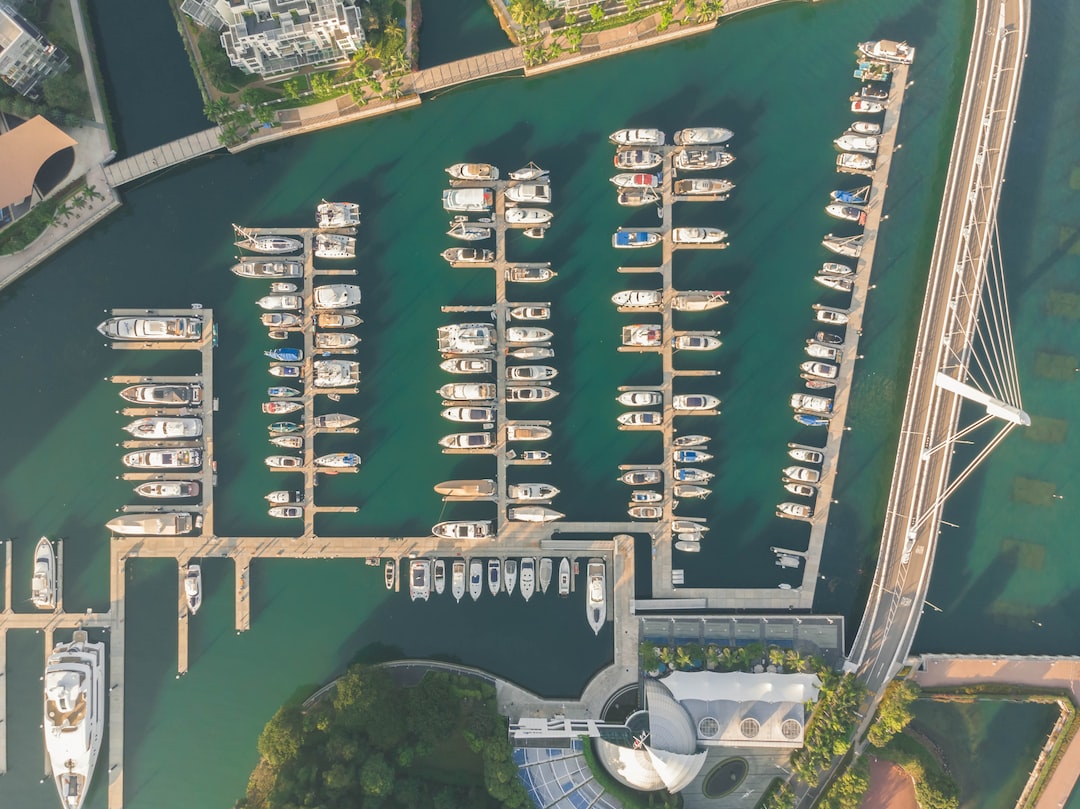
How fast is the hydrofoil catamaran?
Hydrofoil catamarans can reach impressive speeds, depending on various factors such as the design, wind conditions, and skill of the sailor. Some high-performance hydrofoil catamarans can exceed 40 knots (46 mph) or more. However, the exact speed will vary based on these factors.
How does a foil catamaran work?
A foil catamaran, also known as a hydrofoil catamaran, works by utilizing hydrofoils to lift the hulls out of the water. These foils generate lift as the boat gains speed, reducing drag and allowing for faster and smoother sailing. The lift created by the foils enables the catamaran to “fly” above the water, resulting in increased speed and improved performance.
What happened to hydrofoils?
Hydrofoils have a rich history and have been used in various applications, including passenger ferries, military vessels, and recreational boats. While hydrofoils experienced a surge in popularity in the mid-20th century, their use declined in some sectors due to factors such as high costs, maintenance challenges, and the development of alternative technologies. However, hydrofoils continue to be used in niche markets, including high-performance sailing and racing.
Read more about “… What is the World’s Largest Hydrofoil Boat?”
Are hydrofoil boats more efficient?
Yes, hydrofoil boats are generally more efficient than traditional boats. By lifting the hulls out of the water, hydrofoils reduce drag and allow the boat to sail faster while using less power. This increased efficiency translates to longer sailing distances and reduced fuel consumption. However, it’s important to note that the efficiency gains may vary depending on factors such as the design, sailing conditions, and skill of the sailor.
Hydrofoil catamarans offer an exhilarating and thrilling experience on the water. With their incredible speed, maneuverability, and stability, they have become a favorite among sailors and water sports enthusiasts. While they may come with a higher price tag and require some skill to master, the rewards of foiling on a hydrofoil catamaran are well worth it.
When choosing a hydrofoil catamaran, consider factors such as your skill level, intended use, budget, and the reputation of the brand. Take the time to research and test different models to find the perfect catamaran for your needs.
So, are you ready to take flight on a hydrofoil catamaran? Embrace the thrill, experience the freedom, and enjoy the incredible sensation of soaring above the water. Happy foiling!
- Hydrofoil History
- Advanced Hydrofoiling Techniques
- Hydrofoil Equipment Reviews
- Why do boats not use hydrofoils?
- iFLY15 – iFLY Razzor Pro – Foiling Catamaran
- Hydrofoil Catamarans on Amazon
- Hydrofoil Catamarans on Walmart
- Hydrofoil Catamarans on Etsy
Review Team
The Popular Brands Review Team is a collective of seasoned professionals boasting an extensive and varied portfolio in the field of product evaluation. Composed of experts with specialties across a myriad of industries, the team’s collective experience spans across numerous decades, allowing them a unique depth and breadth of understanding when it comes to reviewing different brands and products.
Leaders in their respective fields, the team's expertise ranges from technology and electronics to fashion, luxury goods, outdoor and sports equipment, and even food and beverages. Their years of dedication and acute understanding of their sectors have given them an uncanny ability to discern the most subtle nuances of product design, functionality, and overall quality.
Related Posts
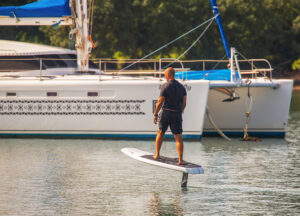
Can You Hydrofoil Without Waves? 10 Surprising Insights You Need to Know! [2024] 🌊
- August 28, 2024
The Ultimate Guide to Foiling Boards: 12 Secrets You Need to Know for an Epic Ride [2024] 🏄♂️
- August 24, 2024

How to Get Up on a Hydrofoil: 12 Essential Tips for Beginners [2024] 🏄♂️
Leave a reply cancel reply.
Your email address will not be published. Required fields are marked *
Add Comment *
Save my name, email, and website in this browser for the next time I comment.
Post Comment
Trending now

- 2024 BOAT BUYERS GUIDE
- Email Newsletters
- Boat of the Year
- 2024 Freshwater Boat and Gear Buyers Guide
- 2024 Boat Buyers Guide
- 2024 Water Sports Boat Buyers Guide
- 2024 Pontoon Boat Buyers Guide
- Cruising Boats
- Pontoon Boats
- Fishing Boats
- Personal Watercraft
- Water Sports
- Boat Walkthroughs
- What To Look For
- Watersports Favorites Spring 2022
- Boating Lab
- Boating Safety
- Ultimate Boating Giveaway

Using Hydrofoils to Improve Boat Performance
- By Capt. Vincent Daniello
- March 15, 2024
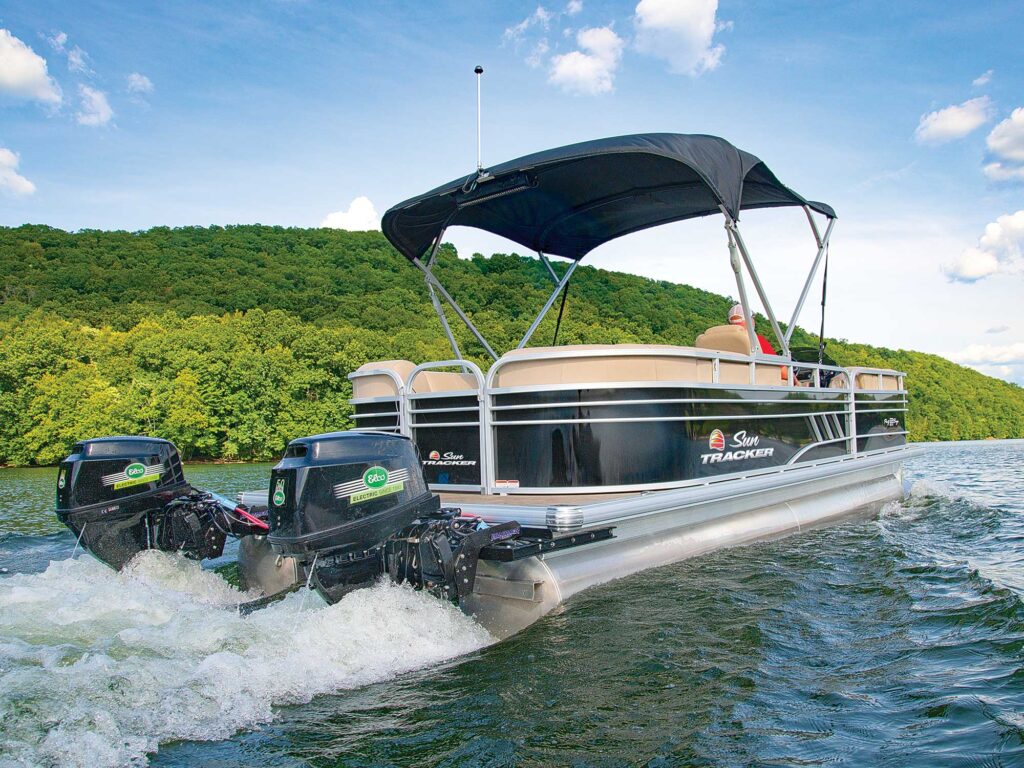
In my early days as a captain, few boats cruised faster than 30 mph. Back then, bigger engines and the fuel they burned added too much weight, netting little more speed. Today, even modest performers top 50 mph thanks to lighter engines and boat construction, where more ponies push fewer pounds.
Electric propulsion leaves boats yet again struggling in that extra-pounds paradigm. Adding fuel— measured in kilowatt-hours of lithium batteries—attenuates attempts to go faster and farther, at least until batteries become lighter. But there might be another way. I tested an electric-powered SunTracker Party Barge 22 DLX both before and after Hydrofin installed its hydrofoil system, which lifts a boat while moving through the water. This effectively overcame 800 pounds of lithium iron phosphate (LiFePO4) batteries—40 kilowatt-hours—that fueled twin Elco EP-50 electric outboards. In the end, flying on foils increased the boat’s speed by well more than a third and improved efficiency markedly. So, what are hydrofoils, and can they enhance performance aboard other boats too?
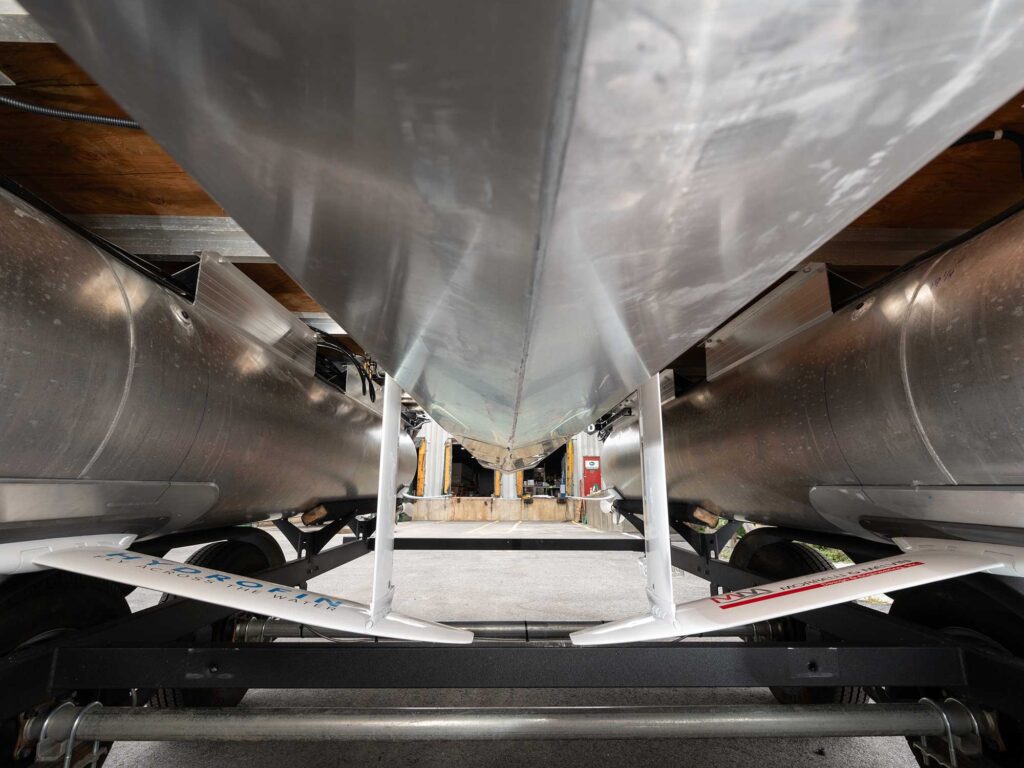
Performance Takes Flight
“We’re a long way from batteries that provide lightweight energy. Our hydrofoils create lift to overcome that additional weight,” says Jason Minor, Hydrofin’s founder. The patented system, engineered by noted catamaran and America’s Cup sailing foil-design firm Morrelli & Melvin of Newport Beach, California, utilizes powder-coated aluminum foils—essentially underwater wings. Mounting pads epoxied to hulls allow incremental adjustment of location and angle of attack, so Hydrofin foils lift nearly half a boat’s weight. “A typical bi-toon with a gas 150 runs around 30 mph. Adding Hydrofin foils can easily make it run 37 to 39 mph,” Minor says, adding that 30 percent better economy is common at cruising speeds. Riding higher on wings makes boats run smoother, dryer and quieter too. (See our Hydrofin test on a Misty Harbor 2528 pontoon with a Merc 150 hp gas outboard at boatingmag.com/hydrofin .)
Put to the Test
Hydrofin foils lifted so much battery weight that our Elco-powered test boat required larger propellers to see full improvement. Comparing performance from the final propellers, with foils removed, the boat reached 17.2 mph turning just 5,400 rpm and drawing an overloaded 67.2 kW. With Hydrofin foils installed, those same props turned 5,750 rpm to reach 24.9 mph at 58.56 kW. The original propellers, without hydrofoils, reached 6,000 rpm and 17.9 mph while consuming 49.06 kW, which we used to compute 39 percent increased speed and 16 percent improved efficiency with hydrofoils installed.
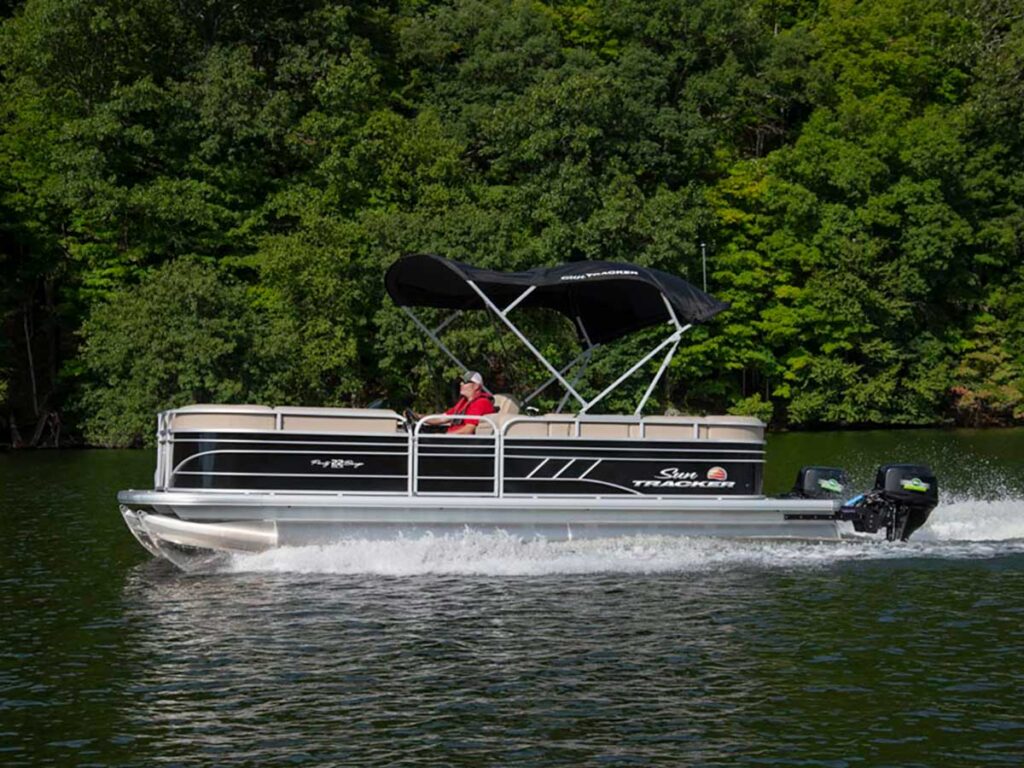
Worth the Weight
Minor says that about one-third of installations benefit from new props, which is expected when essentially lightening a boat by half. Those underwater wings alleviate passenger weight too, which often impacts gas-powered pontoon boatspeed. “A boat might lose 6 or 8 mph when full of people,” Minor says, versus carrying minimal crew. “That same boat would see just a 2 or 3 mph drop with our hydrofoils installed.”
Tri-toons, with lift from a third hull and planing strakes, tend to benefit a bit less. Minor says that gas tri-toons typically see 15 to 25 percent increase in speed or fuel economy. On a 25-foot Qwest Tri-toon powered with a prototype 350 hp equivalent Hyper Electric outboard and 1,150 pounds of batteries, Minor reported that the boat gained from 15 percent to 29 percent efficiency in the 20 to 35 mph cruising range. Hydrofin foils proved 7 percent more efficient at 43 mph, which was wide-open throttle without the foils, and they added 6 mph top speed, reaching 49 mph at the same 270 kW. (See our test of the Hyper Electric in Motorhead on page 74.)
Foil Downsides
While Minor was installing the Elco-powered test boat’s foils—about a half-day procedure—I kept an eye out for pitfalls. Foils increase draft by about 4 inches, but they’re mounted well aft of amidships, where they shouldn’t interfere at most beaches. Modifying the boat trailer’s inner bunk impacted aligning the boat back onto the trailer at the ramp, but this can be easily remedied with side guide pipes common on monohull trailers. In a hard grounding or collision, foils are engineered to break away, and Minor reports no damage to hulls or mounting pads, only foils themselves, in the few times it has occurred. Operating in very shallow water would surely be problematic, but Hydrofin’s optional electric-actuated system fully retracts well above a pontoon’s bottom.
Other Boats
Hydrofin’s system adapts to nearly all pontoon and tri-toon boats, and they’ll work on small power catamarans but not monohulls. “The foils need a gap away from the hull,” Minor explains, which comes when they’re mounted between two hulls. Hydrofin’s foils also won’t work past about 55 mph, when water flow causes foil cavitation.
Long-standing wisdom maintains that more ponies pushing fewer pounds increases speed. That’s still true, but Hydrofin shows that boats can also grow wings and fly.
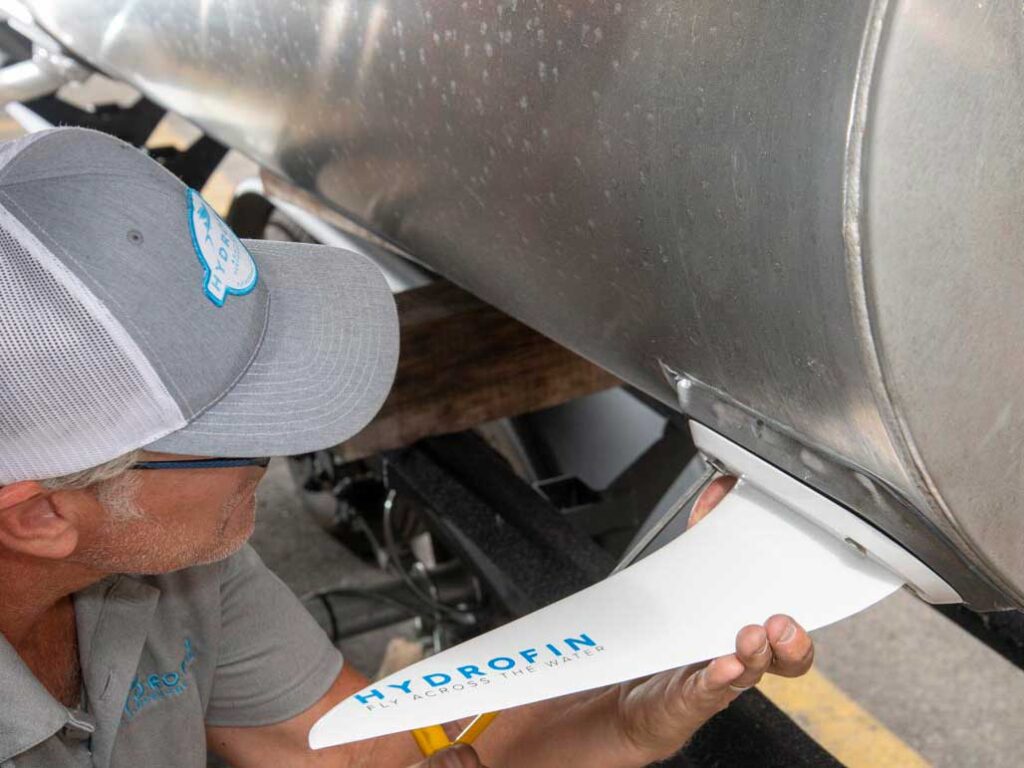
How Hydrofin Foils Attach to the Hull
On twin-hull boats, Hydrofin hydrofoils mount to pads epoxied to hulls between pontoons, with braces extending upward to the deck. Foil location and angle of attack adjust fore-and-aft trim and total lift. Finlets mounted aft add more lift to further tweak the boat’s ride and trim.
Oversize fins, chosen to carry battery weight, range from 343 to 1,822 pounds lift at 25 mph.
Tri-toons utilize a modified mount and fins that create from 537 to 1,021 pounds of lift at 25 mph, where a 25-foot Qwest tri-toon with Hyper Electric Marine’s 350 hp electric outboard was 29 percent more efficient with Hydrofin foils installed, while top speed increased by 6 mph, according to Hydrofin.
- More: April 2024 , boat building , Boats , NextMarine
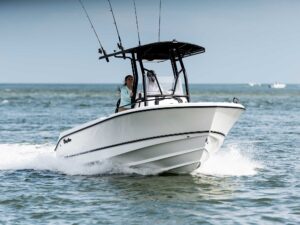
Boat Test: 2024 EdgeWater 208CC Watchman
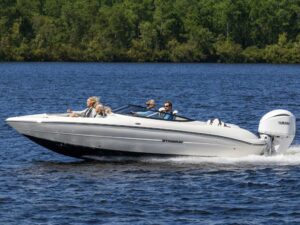
Boat Test: 2024 Stingray 23 OSX
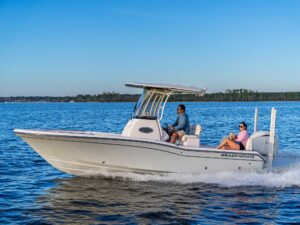
Boat Test: 2024 Grady-White 231 Coastal Explorer
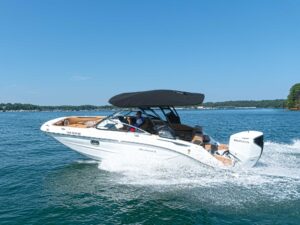
Boat Test: 2024 Hurricane SunDeck 2600 OB
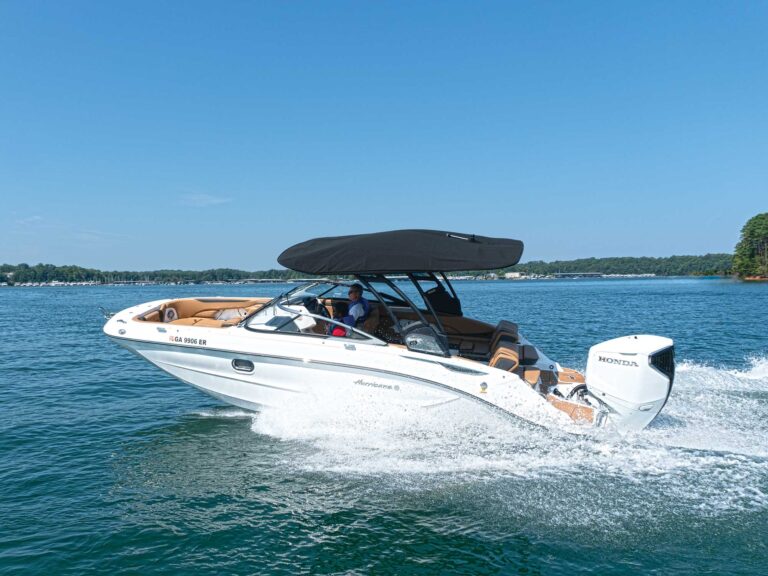
Boat Test: 2024 Brabus Shadow 1200 Sun-Top
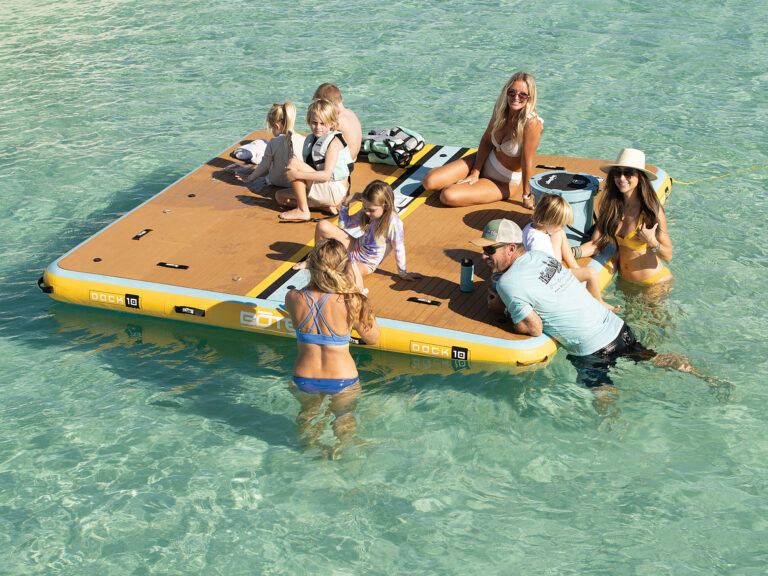
Inflatable Water Mats for Boaters
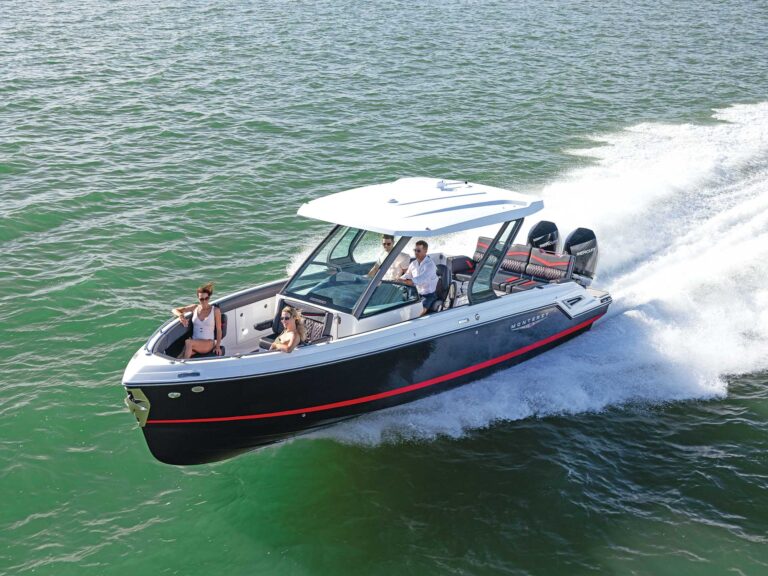
Boat Test: 2024 Monterey Elite 30

- Digital Edition
- Customer Service
- Privacy Policy
- Terms of Use
- Cruising World
- Sailing World
- Salt Water Sportsman
- Sport Fishing
- Wakeboarding
Many products featured on this site were editorially chosen. Boating may receive financial compensation for products purchased through this site.
Copyright © 2024 Boating Firecrown . All rights reserved. Reproduction in whole or in part without permission is prohibited.
ACTIVE STORM TRACKER Hurricane and Tropical Storm Information Learn more

Service Locator
- Angler Endorsement
- Boat Towing Coverage
- Mechanical Breakdown
- Insurance Requirements in Mexico
- Agreed Hull Value
- Actual Cash Value
- Liability Only
- Insurance Payment Options
- Claims Information
- Towing Service Agreement
- Membership Plans
- Boat Show Tickets
- BoatUS Boats For Sale
- Membership Payment Options
- Consumer Affairs
- Boat Documentation Requirements
- Installation Instructions
- Shipping & Handling Information
- Contact Boat Lettering
- End User Agreement
- Frequently Asked Questions
- Vessel Documentation
- BoatUS Foundation
- Government Affairs
- Powercruisers
- Buying & Selling Advice
- Maintenance
- Tow Vehicles
- Make & Create
- Makeovers & Refitting
- Accessories
- Electronics
- Skills, Tips, Tools
- Spring Preparation
- Winterization
- Boaters’ Rights
- Environment & Clean Water
- Boat Safety
- Navigational Hazards
- Personal Safety
- Batteries & Onboard Power
- Motors, Engines, Propulsion
- Books & Movies
- Cockpit Confessions
- Communication & Etiquette
- Contests & Sweepstakes
- Colleges & Tech Schools
- Food, Drink, Entertainment
- New To Boating
- Travel & Destinations
- Watersports
- Anchors & Anchoring
- Boat Handling
- ← Technology
Hydrofoils: Boats That Fly
Advertisement
Hydrofoils make everything from water skis to sailboats to giant ferries faster (much faster). But how the heck do they work?
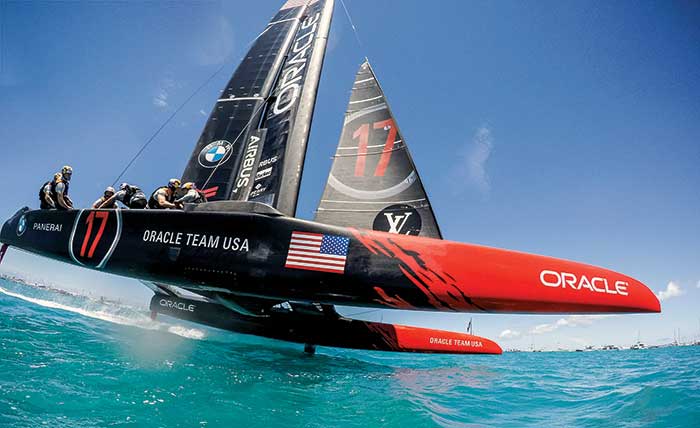
Oracle Team USA's AC50 "flying" at nearly 50 mph. (Photo: Ricardo Pinto)
Ever wonder why a sleek, powerful recreational boat is not even as fast as a typical economy car? It has to do with friction. An economy car needs a little over 100 horsepower to speed by at 100 mph, but pushing a boat through the water that fast takes several hundred horsepower. The reason is that water is almost 800 times denser than air.
Imagine standing on your dock in a 10-knot wind — it's not hard to do. Now imagine being in a river trying to stand up to a 10-knot current. The water is so much denser that no matter how strong you are, you'd be swept away. A boat hull has to push through all that dense water while a car can slip through the air much easier.
Planing boats are able to go faster than displacement boats because they lift part of their hull out of the water as they race over their bow wave, but there's still a lot of friction from the water on the rest of the hull. If you could get the hull all the way out of the water, you'd eliminate that friction, and the boat could go faster with the same amount of power.
The Science
Most of us have a pretty good understanding of how an airplane flies. As air flows over and under the wings (also called airfoils), it creates lift. Once an airplane is going fast enough, the lift that the wings create allow it to rise above the earth.
If you were to mount a wing or two (called hydrofoils) under a boat, all that dense water can be put to good use by pushing the boat's hull out of the water. Then friction only acts on the small foils, not on the whole hull, which is why a 130-foot hydrofoiling sailboat can "fly" at over 50 knots. Powerboats have added friction from the propulsion system that has to remain in the water, but even then, large hydrofoiling ferries can exceed 45 knots.
Speed is not the only advantage that hydrofoils give boats. Because the hull is out of the water, all the energy from waves that would normally pound against the boat pass harmlessly underneath it, creating an eerily smooth ride. Even so, hydrofoiling is typically best in somewhat protected waters.
Don't look for hydrofoils on your next runabout anytime soon because they're much more difficult to engineer and typically triple the cost of a boat. The good news is that there are other ways to 'foil that are affordable — see "Experience Hydrofoiling For Yourself" at below.
Experience Hydrofoiling For Yourself
Hydrofoil kiteboards.
If you've even seen a kiteboard zooming in a strong breeze, you know they're plenty fast. Add a hydrofoil, and suddenly you add a new dimension. These boards take lots of skill and practice to master, but the ride is said to be much smoother and even faster than a conventional kiteboard. Cost starts at around $1,000.
Hydrofoil Waterskis
These single-ski hydrofoils are really a sit-on-ski, and once you've mastered the technique, the foils will lift you up and you'll be "flying." Unlike conventional skis, these aren't designed for speed, and 18 mph is where they typically "liftoff' and suggested top speed is about 25 mph. It's also important not to ski in shallow water due to the depth of the foils. Cost is typically $1,500 and up.
Hydrofoil Windsurfers
Not content to take a surfboard and add a sail, windsurfers developed foils that allow the board to "levitate." The biggest advantage is the smoothness of the ride — a real benefit because these rigs usually sail in very strong winds with plenty of chop. Cost is about $2,500 to get started.
Hydrofoiling Small Sailboats
You don't have to spend millions on a boat like the America's Cup racers if you want to hydrofoil. The Waszp costs about $10,000, though even for dinghy racers, there's a learning curve to get these boats on their foils, with speeds up to 27 mph.
Note that most companies suggest wearing a helmet when using foiling products because of the speeds achievable and the hard, sharp foils these devices have.
Foiling The Competition
America's Cup boats are often what people think of when they hear the word "hydrofoil." Hal Youngren, an aeronautical engineer and one of the designers for the 2013 and 2017 America's Cup racers, says the difference in speed that foils make is impressive. The fastest nonfoiling catamarans in previous races could barely reach 35 knots, while the 2017 foiling cats hit 50 knots. Youngren says that these 50-foot cats are able to lift their hulls completely out of the water using only about three-quarters of a square meter of foil area (about the size of a medium-sized TV). Below about 15 knots, he says, the boats sail much like a nonfoiling boat with hulls in the water, but once over that speed, the boats start to "fly" and their speed dramatically increases.
The America's Cup Class AC75 Boat Concept Revealed
An exciting new era in America's Cup racing was unveiled in November 2017 as the concept for the AC75, the class of boat to be sailed in the 36th America's Cup is released illustrating a bold and modern vision for high performance fully foiling monohull racing yachts.
The America's Cup AC75 Boat Concept Revealed
The Emirates Team New Zealand and Luna Rossa design teams spent the previous four months evaluating a wide range of monohull concepts. Their goals have been to design a class that will be challenging and demanding to sail, rewarding the top level of skill for the crews; this concept could become the future of racing and even cruising monohulls beyond the America's Cup.
The AC75 combines extremely high-performance sailing and great match racing with the safety of a boat that can right itself in the event of a capsize. The groundbreaking concept is achieved through the use of twin canting T-foils, ballasted to provide righting-moment when sailing, and roll stability at low speed.
An underlying principle has been to provide affordable and sustainable technology "trickle down" to other sailing classes and yachts. While recent America's Cup multihulls have benefitted from the power and control of rigid wing sails, there has been no transfer of this technology to the rigs of other sailing classes. In tandem with the innovations of the foiling system, Emirates Team New Zealand and Luna Rossa are investigating a number of possible innovations for the AC75's rig, with the requirement that the rig need not be craned in and out each day. This research work is ongoing as different concepts are evaluated, and details will be released with the AC75 Class Rule before March 31, 2018.
The America's Cup is a match race and creating a class that will provide challenging match racing has been the goal from the start. The AC75 will foil-tack and foil-gybe with only small maneuvering losses, and given the speed and the ease at which the boats can turn the classic pre-starts of the America's Cup are set to make an exciting comeback. Sail handling will also become important, with cross-overs to code zero sails in light wind conditions.
A huge number of ideas have been considered in the quest to define a class that will be extremely exciting to sail and provide great match racing, but the final decision was an easy one: the concept being announced was a clear winner, and both teams are eager to be introducing the AC75 for the 36th America's Cup in 2021. — AmericasCup.com
Related Articles
The truth about ceramic coatings for boats.
Our editor investigates the marketing claims of consumer-grade ceramic coatings.
Fine-Tune Your Side Scan Fishfinder
Take your side-scanning fishfinder off auto mode, and you’ll be spotting your prey from afar in no time
DIY Boat Foam Decking
Closed-cell foam flooring helps make boating more comfortable. Here’s how to install it on your vessel
Click to explore related articles
Charles Fort
Contributing Editor, BoatUS Magazine
Charles Fort is BoatUS Magazine's West Coast Editor. He often writes local news items for BoatUS Magazine's Waypoints column and contributes to Reports, in-depth tech features in every issue written to help readers avoid accidental damage to their boats. He is a member of the National Association of Marine Surveyors, he's on ABYC tech committees, and has a 100-ton U.S. Coast Guard license. He lives in California.
BoatUS Magazine Is A Benefit Of BoatUS Membership
Membership Benefits Include:
Subscription to the print version of BoatUS Magazine
4% back on purchases from West Marine stores or online at WestMarine.com
Discounts on fuel, transient slips, repairs and more at over 1,200 businesses
Deals on cruises, charters, car rentals, hotel stays and more…
All for only $25/year!
We use cookies to enhance your visit to our website and to improve your experience. By continuing to use our website, you’re agreeing to our cookie policy.

Ready to get started?

Designed with a singular vision...To deliver unmatched performance and efficiency!
Introducing the insetta 35ifc – the bar has been raised.
The Insetta 35IFC was designed with a singular vision… to be the best-performing center console sport fishing catamaran in its class. Enjoy unmatched performance, range, and efficiency thanks to the 35IFC’s hydrofoil-assisted design.
In addition to being the best High-Performance Fishing Catamaran in its class, it also provides a smoother and dryer ride in the rough stuff!
This boat was designed for people who fish, by people who fish! From its integrated livewells to its cavernous coffin boxes, level open deck layout, massive insulated storage and so much more, this boat was designed for maximum range and fishability!
Here’s what our customers have to say: “Holy crap do I love my 35 IFC with the Merc 300 V8’s on the back. We ran her down to Key Largo the other day, snorkeled all day, got lunch at Shipwrecks Bar and Grill, and ran back. Cruised between 40 and 45 mph, mostly around 42. So smooth it’s nuts. Burned maaaayyybe 40 gallons for the whole day. As we cruised the dashboard was telling us between 1.7 and 1.8 mpg, but I’m pretty sure we cruised more than 40 miles and burned between 35 and 40 gallons, no more. So… suffice it to say that you guys have absolutely crushed it and changed the game here. Fantastic work”! – Alan, Hull #4
Check out our FAQ’s section below for more about the Insetta 35 with IFC!
Specifications
Length Overall
Maximum Beam
Maximum Draft
Fuel Capacity
Cruise Speed
Cruise Miles Per Gallon (MPG)
Over 850 miles*
Cruise Range
Standard Features
Standard “Insetta White” Gelcoat Molded in Diamond Non-Skid Tackle Storage Stbd Side Tackle Storage Port Side 19 Gallon Freshwater Washdown/Shower 5 x In Deck Storage Hatch 2 x In Deck Macerated Fish Boxes 625 Qt Insulated Coffin Box, Split Boxes Walk through Transom Access (Door Optional) Two 36 gallon Integrated Transom Livewells Fresh and Raw Water Washdown 34 Rod Holders (gunnels and coffin box) 7 Stainless Gemlux Pull-Up Cleats LED Navigation Lights Boarding Ladder
Recessed Stainless Bow Rail
Helm / Console
Fiberglass Hardtop with Powder Coated Aluminum Supports Tempered Safety Glass Enclosure for Console 6 Integral Rod Holders Built into Rear Support Molded Fiberglass Leaning Post with Rear Face Seating and cooler 3 Wide Helm Seats 6 S/S Cup Holders Storage Box and Rigging Tray on Rear Facing Seat Storage Drawers Under Helm Seats 165 Qt Leaning Post Ice Box Located Under Rear Face Seats
Base Upholstery
Equipment and Electronics
3 Part Internal Foil System
3 Pump Capacity Sea Chest with Dual Livewell Pumps & Raw Water Feed
4 1100 GPH Bilge Pumps (2 in Each Sponson)
Standard Capacities
490 gallon fuel capacity.
625 Qt Insulated Coffin Box with Divider
165 Qt Leaning Post Ice box
Dual 36 Gallon Livewells
19 Gallon Freshwater
Frequently Asked Questions
IFC is Insetta Boatwork's Internal Foiling System.
You can expect a significant increase in cruise speed; Improved handling and stability in rough conditions; Better acceleration; A boat that is less affected by increased payload; A 20-40% increase in fuel efficiency; and a 20-40% further cruise range! Additionally, the IFC technology will also provide a drier ride in choppy conditions and Provide for more responsiveness when turning at speed!
The system is a fixed setup, there is nothing to operate and there are zero moving parts.
The IFC Technology in effect smooths out rough seas by allowing the boat to run from wave crest to wave crest at a relatively smooth and stable attitude. The IFC System creates lift which help to in effect “Carry” the hull higher in the water. The system acts as a set of wings carrying the boat at speed, keeping the hull from having to follow each wave across its entire contour. In other words the surface of the waves have less effect on the hull as the IFC system is lifting the boat. Additionally, the aerodynamic lift created by the catamaran hulls creates even more lift at the bow of the boat, keeping the nose high and preventing the “slamming” or sneezing found in other catamaran hulls.
No, you don’t. The foils are flush mounted to the bottom of the keels of each sponson (as well as up in the tunnel.) At its centerline the main foil of the IFC system is only slightly lower than the keel line. The boat will easily load onto a standard catamaran trailer. There is no big contraption hanging way down under the boat.
Remember, the foils are INTERNAL to the tunnel. At its lowest point the main foil is only slightly lower than the hull and is higher than the props. Because of this the odds of striking the foils are extremely low. The boat is designed to be lifted by the foil. The structural integrity of the foil system is such that the weight of the boat could be supported many times over by the foil. As such, if you did somehow manage to strike the foil on something EXTREMELY SUBSTANTIAL, like a stone shoal, the likely outcome is that you may (in a very worst case scenario) bend or break a foil wing. If that were to happen, you could still operate the boat to port with the remaining foils. The IFC foils are made from a very high-grade stainless steel and designed to meet or exceed relevant guidelines for impact and strength.
As water travels through the tunnel and around the foil, a tremendous vortex is created. This force keeps most debris from being trapped in the tunnel or around the foil. Between the pressure of the air moving through the tunnel, and the vortex created in the water, the tunnel and foils will stay clean and clear.
The outboards of the 35 IFC are mounted on a slight outward angle to place the propellers properly to maximize the thrust and flow efficiency created as the water travels through the tunnel and around the foils. This mounting also helps the boat to lean into a corner, much like a monohull.
Firstly, we’d ask, “Why would you want to?” But the short answer is no. IFC is an integrated system that is integral to the design of the boat.
The short answer is that boats with technology similar to IFC have been in use for many years, but not in the recreational market. Commercial and Military applications are quite prevalent. The initial design of a hull and system like this is quite complex and can be cost prohibitive. We at Insetta feel the gains in efficiency, speed, range and ride quality far outweigh the initial design and build cost.
Upon deciding to build a foiling Cat, Insetta assembled a team of naval Architects and Marine Engineers to refine an existing and proven design. Using their own state of the art construction techniques, Insetta brought an application specific version to the fiberglass Center Console market.
Optional Features
Customizable Garmin or Simrad Electronics JL Audio 10 Speaker Stereo System Flush Mount Acrylic Helm Bow Shade Custom Gelcoat or Combination of Colors Deluxe Upholstery Third Center Livewell Under Rear Facing Seat 40 gallon Seadek Flooring or Flexiteek Decking Additional Gunnel Rod Holders (18 standard) Recessed Wireless Phone Chargers Swivel Base Rod Holders Outlets for Electric Reels Additional Drink Holders on Leaning Post, Coffin Box, Gunnels and Helm Forward/Rear/Side Spreader Lights T-Top Outrigger Bases/Poles Gemlux Electric Head With 19 Gallon Blackwater Holding Tank Freshwater Sink and Vanity Inside Console Underwater Lights Heavy Duty Dive Ladder LED Under Gunnel Lighting On-Board Battery Charger Windlass Custom Aluminum Trailer Cockpit Table/Bow Table
Why did Insetta Boatworks decide to build a boat with IFC?
For decades, Hydrofoil power boats have proven to be the most efficient craft for a variety of offshore operations.
While pursuing a B.S. in physics in 1960, Victor Insetta was employed doing anti-submarine research that utilized high speed Deep-V patrol boats equipped with hydrofoils. Their ability to pursue submarines at high speed, operate safely offshore, and, being foil borne: allowed their hull to run clear of the water avoiding direct hits from torpedoes. Decades later, Vic and his family rode comfortably on hydrofoil ferries in Italy, flying over white capped waves in the bay of Naples.
In 2017, The Insetta 45 was chosen to be the official chase boat of the America’s cup! Four 45’ Insetta’s catamarans were shipped to Bermuda to assist at various cup events. Sailboats, competing from several countries, were catamarans with hydrofoils ! The Insetta 45’s ran parallel to these “foiling sail cats” to assist with TV coverage. The sailing cats were traveling at speeds approaching 50 mph, 2 ½ times the wind speed . Efficient … you bet . They could also turn on a dime at over 40 mph…
It became obvious: that a foiling cat would make a great offshore outboard power boat… Many foil power boat designs in the past, had wide foils that stuck out the sides, increasing their beam and draft. It made them difficult to dock, and they couldn’t operate in shallow waters. Joel Shine (chief operating officer) of Insetta Boatworks found a catamaran design that had hydrofoils mounted in the tunnel, (that location between the tunnel walls actually improves their efficiency), and does not add to its draft. Further improvements could be added by using our ultra-light high strength infused composite construction.
Joel, Vic and our technical staff reviewed the foiling cat’s initial specifications and performance data, and then sea trialed two foiling cats with internal hydrofoils. Our staff includes a second physicist and pilot… Glen Dobbs. We are all active boaters and we determined we would build our version of a foiling outboard powered cat. We contacted a Naval architect, who designed several successful foiling power cats . He is now a member of our technical staff.
Our 35 “foiling cat” design has set the standard for Foil-Assisted Sportfishing boats. The hull, foils, materials, and engines are synergistically combined, to provide: unrivaled high-speed cruising efficiency , and provide safe offshore handling, with unimpeded shallow water operation, including beaching, without foils or props contacting the bottom.
Insetta 35IFC
The premier internal foiling catamaran.

Integrated 36 Gallon Livewells & 625 QT Coffin Box Standard
Designed to fish.

850+ Mile Range!

Best in Class MPG, Smoother/Dryer Ride!
Performance.
Click the button below to contact or email us for more info!
Latest News

The Foiling Press – February 2024
The Foiling Press – February 2024 – February was a busy month for…

The Foiling Press – January 2024
We kicked off the year with a full house here at Insetta Boatworks! Three beautiful 35IFC’s in…

The Foiling Press – December 2023
The Foiling Press – December 2023 – We’ve wrapped up an incredible year…

The Foiling Press – August 2024
The Foiling Press – August 2024—Summer has…

The Foiling Press – July 2024
The Foiling Press – July 2024 – Welcome back to another edition of our monthly newsletter, The…
Get the Latest Insetta News!
Share this page

Looking for our latest catalog?
Yachting World
- Digital Edition

Foiling and Hydrofoiling: Everything you need to know

A foiling International Moth dinghy. Photo: Christopher Ison / Alamy
What is foiling?
Although foiling or hydrofoiling feels like a recent revolution to take the world of watersports by storm, it is actually much older than many appreciate.
In terms of motorised waterborne craft, the first foiler was a motorboat designed and built by Italian inventor Enrico Forlanini in 1906.
It did, however, take quite a bit of time before foiling boats with sails took to the water, but even then many people might be surprised to learn that even in the 1970’s the foiling trimaran, Williwaw, covered over 20,000 sea miles in and around the South Pacific all on its foils.
It turns out the history of hyrofoiling goes back further than many think.
It was not until the early-2000s that foiling really started to take hold, with a development dinghy class, the International Moth, leading the way.

Foiling boats
With huge amounts of interest in the 11ft Moth dinghy, foiling began to spread throughout the sport of sailing. And it was not long until hydrofoiling boats of all different shapes and sizes were taking the water.
Over time, some traditional classes converted to foiling – the A-Class and C-Class catamarans being examples. But more new boats were also designed specifically with hydrofoiling in mind.
In 2013 Emirates Team New Zealand built their 72ft America’s Cup catamaran to be a foiler, forcing their competition for the Cup, Oracle Team USA to convert their AC72 into a foiler to stay competitive – ultimately Oracle Team USA won the Cup in one of the biggest sporting comebacks of all time .
To date the America’s Cup has not looked back with the competition taking place in smaller hydrofoiling AC50 catamarans in 2017 and the newly conceived monohull foilers, the AC75 s, in 2021.
In 2021 the Olympics Games introduced the first ever foiling catamaran in the Nacra 17.
Foiling yachts
Offhsore, 90ft Ultime multihulls on their foils are competing to be the fastest to race around the globe and design houses across the globe are racing to create foiling yachts for the masses which could dramatically reduce cruising times from one destination to the other.
There are also many classes of yacht that are taking some of the lessons from fully foiling craft and putting them to use in a semi-foiling manner.
Here the biggest technical innovation is in the IMOCA60 class, which is famously used for the single handed non-stop round the world race, the Vendée Globe .
The latest couple of generations of IMOCA 60s have been build with huge, technologically complex foils to generate lift. These are powerful enough to lif the boats fully out of the water, but as yet the class rules do not allow for rudder foils which would stabilise flight and allow for full foiling.
Where sailing boats and yachts have, arguably led the way in the history of foiling over the past decade or so this has filtered down into a plethora of other watersports craft.
Although in the early days foiling was typically the preserve of elite sailors and watersports professionals, increasingly we have seen boats and boards designed to foil in the hands of the average sailor, surfer or windsurfer.
This race to bring the fun of foiling to beginners is continuing apace with beginner foiling boats, windsurfers, surfers etc. coming to the market every year.

How to watch the Louis Vuitton Cup Semi-Final – the America’s Cup challenger series streams
- September 12, 2024
The America’s Cup Challenger Selection is set to continue on Saturday 14 September 2024, as the four teams that made it through the Round Robin series move on to the…

The 10 best foiling dinghies: fun ways to get flying for all abilities
- July 16, 2024
Foiling used to be the preserve of a select few elite-level athletes, but a couple of decades of work by enthusiasts determined to broaden participation has resulted in a slew…

12 dream sailing experiences – from dreamy adventures to high-octane thrills
- May 15, 2024
We’re all seeking experiences. Whether that’s taking on a sporting challenge, going on above-averagely-adventurous holidays, or learning a new hobby or skill, we live in an era where ‘doing’ is…

Ainslie’s team reveals Britain’s new America’s Cup boat
- April 20, 2024
The British America’s Cup team has become the fourth challengers to unveil their new AC75. INEOS Britannia revealed their AC75 in the early hours of morning, as the foiling monohull…

World’s coolest yachts: Monitor – the 1955 foiling boat
- February 29, 2024
“It has to be Monitor, of course! The father of all flying rockets!” says Desjoyeaux. One of the world’s first sailing hydrofoils, Monitor was created in 1955 by Gordon Baker,…

North Atlantic in six days solo: Arkea Ultim Challenge leaders cross the Equator
- January 13, 2024
Less than a week after setting out from the start in Brest, the leading Ultim trimarans in the Arkea Ultim Challenge have crossed the Equator. First to enter the Southern…

Six solo skippers ready to race 100ft foiling multihulls around the world
- January 4, 2024
There are very few ‘firsts’ left in the world of sailing, but one such remaining barrier could be smashed when the Arkea Ultim Challenge Brest sets off from north-west France…

How to turbo-charge a round the world racer
- November 28, 2023
Ahead of me, the bow of Medallia is pointing at the sky. This is not poetic license; I am actually looking upwards at my bowsprit as it rises up, 50ft…

Slingsby and Neuschäfer crowned Sailors of the Year 2023
- November 15, 2023
The 2023 Rolex World Sailor of the Year awards were presented to Tom Slingsby and Kirsten Neuschäfer last night at a ceremony by World Sailing in Málaga, Spain. The popular…

Le Cléac’h and Josse win the 2023 Transat Jacques Vabre
- November 13, 2023
French duo Armel Le Cléac’h and Sébastien Josse sailing Maxi Banque Populaire XI have won the Transat Jacques Vabre 2023, crossing the finish line at 18:19hrs local time (22:19hrs UTC)…

We’re astounded by this new foiling superyacht: Baltic 111 Raven
- October 19, 2023
Wow…! This foil-assisted, ultra-lightweight superyacht breaks new ground in many respects and Baltic says it is “one of the most extreme yachts” the yard has built in its 50-year history.…

5 reasons to follow the 30th anniversary Transat Jacques Vabre
- October 12, 2023
The Transat Jacques Vabre is one of the ultimate tests of short-handed racing, a double-handed dash from France that sees many of the world’s top racing machines take on the…

World’s fastest monohull: Malizia-Seaexplorer IMOCA 60
- August 17, 2023
Followers of the IMOCA 60 fleet will know that two names have dominated the class over the past two generations when it comes to design: VPLP and Verdier. So, it’s no…

IMOCAs win race to Cherbourg with Macif first monohull in Rolex Fastnet Race
- July 24, 2023
In the battle of the big boats it was the brand new IMOCA Macif, skippered by Charlie Dalin with Pascal Bidégorry which was first monohull home to take line honours in…

Rolex Fastnet Race 2023 stacked IMOCA fleet set to entertain
- July 20, 2023
The famous Rolex Fastnet Race always provides an intriguing line up of amateur and professional teams all looking for race glory as they battle the 629nm course from Cowes, round…

Two giant foiling trimarans set for a Fastnet Race battle
- July 18, 2023
As with most big races around the world, bragging rights in the Rolex Fastnet Race race are split into two broad camps, the line honours winners (the first boat to…

First look: Persico 72ft 40-knot foiling cruising cat
- July 7, 2023
The new foiling catamaran design is the result of Persico’s strategy to translate knowledge the yard gains from its work in aerospace, IMOCA 60 and America’s Cup spheres into very…

11th Hour Racing declared winners of The Ocean Race after redress
- June 29, 2023
Charlie Enright’s 11th Hour Racing Team has won The Ocean Race after a jury awarded them redress of 4 points in the final leg of the round the world race,…

World’s coolest: IKA Kitefoil
- June 5, 2023
“Watching the gracefulness of kitefoil racing had me mesmerised the first time I saw it,” explains Will Harris. “It is an example of pure efficiency and use of all and…

F1 star Sebastian Vettel backs new German SailGP team
- May 31, 2023
Four-time F1 World Champion Sebastian Vettel and double Olympic sailing bronze medallist Erik Heil have joined forces, alongside team owner Thomas Riedel, to announce a brand new German SailGP Team.…
NORTH AMERICA'S LARGEST AND MOST ADVANCED DINGHY FACTORY
Country/region
- Australia AUD $
- Austria EUR €
- Belgium EUR €
- Canada CAD $
- Czechia CZK Kč
- Denmark DKK kr.
- Finland EUR €
- France EUR €
- Germany EUR €
- Hong Kong SAR HKD $
- Ireland EUR €
- Israel ILS ₪
- Italy EUR €
- Japan JPY ¥
- Malaysia MYR RM
- Netherlands EUR €
- New Zealand NZD $
- Norway USD $
- Poland PLN zł
- Portugal EUR €
- Singapore SGD $
- South Korea KRW ₩
- Spain EUR €
- Sweden SEK kr
- Switzerland CHF CHF
- United Arab Emirates AED د.إ
- United Kingdom GBP £
- United States USD $

Item added to your cart

fulcrumspeedworks
*NOTE: Sales team will contact you with shipping rates.

WHAT IS IT?
The UFO is a simplistic modern hydrofoiling boat, that allows anyone to fly through the air, freeing the hull from draggy water. More stable than the International Moth -or even a child’s pram- with a simple rig, and a set of fully retractable hydrofoils, all for $11,500 USD the UFO makes flying attainable. Thousands less than it’s nearest competition. Built in the United States in high volume and quality control, the UFO maintains a one-design philosophy, creating close and exciting racing on foils!
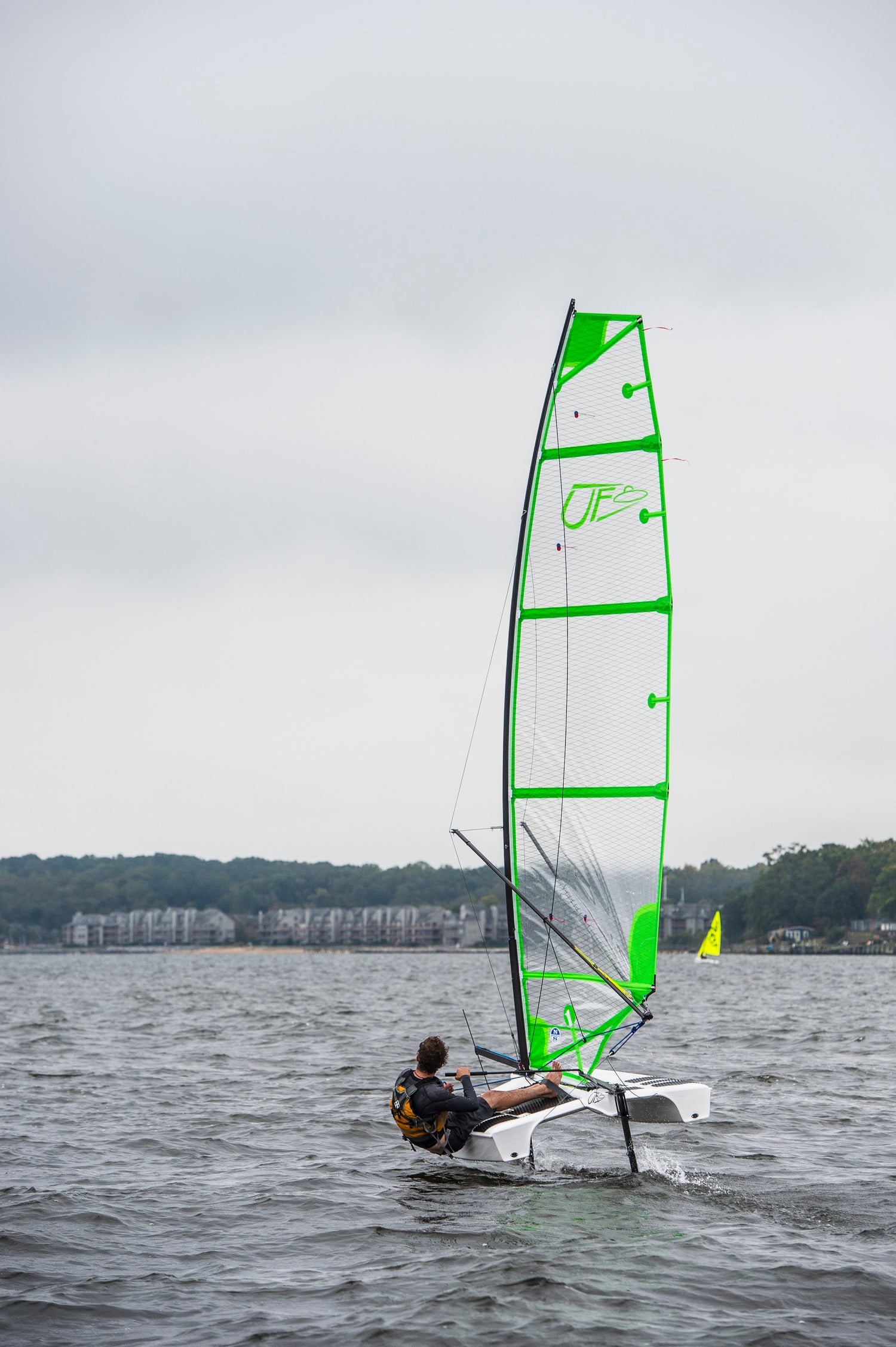
FLY WITH THE UFO
- Designed and built in the USA
- $11,500 USD
- Compatible and rewarding to all skill levels
- Lightweight for easy maneuverability
- Solid, nearly dent-proof, hull
- Unique patented hull and rig designs
- Stable on and above the water
- Small footprint for carefree storage and shipping
- Takeoff from about 8knts of wind
- Fast, fun, easy to control foiling

FUN FOR ALL AGES
The wand system controlling the foils, which can be set to fly very high, very low (even ‘no fly mode’) and all points in between. This means you can progressively add challenges to your UFO experience as you feel ready for them, from ‘beginner mode’ all the way to ‘extreme mode’. Additionally, the highly tunable sail can be set up to provide only the amount of power that your body type needs, and no excess. This means that the UFO is accessible and fun for sailors of all sizes, ages and skill levels. Merely set up the boat for your skill level and body type and go play around.
The UFO is very broadly applicable and has flown payloads from 70 pounds -a tiny kid- to 270 pounds -a tall grown man and a teenage boy-. The foil package just needs power to climb. Ultra light sailors have been caught on camera flying in 5 knots of breeze and the baseline for 225 pound sailors to take off is 10 knots. 270 flies in 12 knots of breeze.
SETUP AND BREAKDOWN
While the boat can be left on shore with everything in place, but the sail down, that doesn’t mean the UFO isn’t easy to put together or take apart. Quite the opposite. Simplicity begets simplicity and the boat is a cinch to put together and take apart.
MANAGEABILITY
Being small is it’s own reward when it comes to handling the boat through all sailing experiences. When you start to really push yourself learning to foil, there are good odds you’ll manage to capsize it. The UFO is easy to right from capsizes and even full “turtle” inversions. This last part is critical, because when catamarans are too heavy to right from turtle the only option is to make the mast float. This has the unintended downside of making the boat very likely to blow away from you. The UFO is designed to stay right alongside you in the event you are separated from the boat. Additionally, the boat possesses an uncommon “park” mode in which it will hold station of its own accord, apparently indefinitely without external input of any kind. The full benefits of that upside have not begun to be fully exploited.

FOILING AT ALL POINT OF SAIL
The Fulcrum design team strictly adhered to the axion “if there’s a point of sail (say, upwind or downwind) that it can’t always foil on, you can’t call it a foiler”. The design team achieved their goal and the UFO is a fully flying boat on all points of sail, which drastically increases its fun-factor.
At what points of sail does the UFO foil at?
The UFO fully foils at all points of sail. Upwind, downwind and reaching. Additionally, you can set it to not foil when you’re tired and it will do that as well, so you can get home easily. These two factors make the UFO uniquely good for learning to foil.
Who can fly the UFO?
Within reason, anyone.
UFO pilots have ranged from 8 years old to 72, from 90 pounds to 235. Young sailors do well sailing as pairs or with a middleweight to light adult. It’s rare that anyone on the fulcrum team conceives of a boat with a narrow niche in mind. Why bother? It’s a mistake in yacht design to design a boat for a narrow range of users, when for the most part people are diverse and the objective of one-design boats is to garner large fleets. That said, the boat is likely to be most satisfactory in all wind conditions in the hands of teens, small and medium men and all women. At the extreme low end of the weight range, sailors may find themselves overpowered and at the extreme high end, the wind speed required for takeoff is about two knots higher than average. UFOs have been sailed “two up” as well, though the above limits of weight range still apply to the sum of the two sailors weights.
What wind and waves can I fly a UFO in?
The UFO will sail in practically any wind condition. However, it’s important to remember that with all sailboats there are days that are great to sail in and days where you do something else.
While the UFO can at times with a skilled skipper take off in very low wind speeds, the baseline for reliable flight is around eight knots. Trying to squeeze enough power to fly out of too little wind is tiresome and in those circumstances, it’s best to do something else. In 8 knots and above, flying is magical and unforgettable. In under 8 knots, the UFO reverts to being a pleasant displacement catamaran and goes from being exciting and fast to relaxing and tactical. This is another benefit of being a catamaran.
Over the last six years the UFO has proven to be uniquely good at flying safely and consistently in very high windspeeds. In multi-class foiling regattas the UFO has proven to be the only foiler built to date that simply loves high windspeeds. In winds above 22 knots when other foiling boats make for shore, the UFO wants to keep playing. The upper wind limit is more a matter of taste and skill. UFOs have been sailed in 36 knots, but that requires a great deal of skill and focus. The UFO rig having shared DNA with a windsurf rig seems to play a part in the boat’s remarkable ability to get a kick out of big wind. Since the upper wind limit on the UFO is so much higher, this makes the number of optimal days to fly a UFO (if skilled in sailing one) higher per year than with any other production foiling boat.
Most chop and wave conditions present no issue for a UFO set for the days’ conditions. After all, powered hydrofoils were first developed by various leading Navy’s as a means of smoothly flying over challenging sea-states. Choking up the ride height helps the UFO fly smoothly through the bottom of the wave pattern, undeterred. Rolling seas present even less issue, as the UFO will ride along them just like any other. Extremely tight and tall chop can be very annoying, which is not peculiar to the UFO.
Waves do effect baseline windspeeds to achieve takeoff. Imagine getting a plane to take off on a bumpy runway. This is true for all hydrofoil boats. In choppy water, ten to twelve knots can be necessary to achieve fully easy takeoffs. Some UFO sailors use aggressive kinetic techniques to overcome this and take off in choppy water and low wind.
Will I fly my first time out?
Most people do, but bear in mind that flying is a whole new experience and it takes some learning.
Conditions, setup and technique matter and if you use it incorrectly, you are likely to get some degree of incorrect results. That’s the challenge that the UFO is built to address. Over six years on the market and over 500 boats delivered, the UFO has proven to be the best and most reliable platform for ordinary sailors to reliably teach themselves foiling technique on.
What happens when I crash my UFO into something?
You’ll probably do some damage to it.
The UFO is built with durability as a core objective but it’s worth noting that the gulf between “Feather light under engineered ragged-edge high performance craft” and “literally indestructible” is extremely wide. The UFO represents neither of these extremes. Do not attempt your first flight inside a densely packed mooring field. Obstacles only make you better once you’ve mastered the basics.
How easy is it to rig a UFO?
Best in class, vs other foiling boats on the market. With that said, it’s not easier than doing nothing. Doing nothing is very easy! Putting a boat together is worthwhile but obviously involves effort.
The current cartop to launched speed record is roughly 15 minutes. Socket the mast together. Attach the boom and stays in one go. Step the rig. Flip the boat on its side, insert the foils, right the boat, hoist the sail and launch. Complexity is best avoided.
Leaving the UFO on a dock or a beach with the rig in and the foils simply in the “up” position, achieves an ease of daily use on par with any light beach cat. To go foiling all you need to do is hoist the sail with the halyard, clip the sail to the boom and attach the downhaul line and you’re ready to launch. This brings setup and breakdown to a matter of five minutes or less.
How do I launch and land a UFO?
Far far far more easily than any other foiling boat on the market.
Because the UFO is a very small catamaran, while floating the hulls float relatively deep in the water and create lateral resistance, like the hulls on a hobie 16 or hobie wave. This means that it can sail upwind without a daggerboard of any kind in the water. This is not the case with non-catamaran foilers. The rudder is outfitted with a friction brake and a down-halyard to allow its depth to vary and allow steering in shallow water. So from 16 inches of water and beyond, you can sail away from and back to shore reliably.
Because the UFO’s forward foil assembly is located in front of the mast, the UFO can tack and gybe while the forward foil is fully withdrawn from the water. This is unique. It allows the UFO to navigate reliably in the period between launching or landing and flying. The benefits for usability and safety cannot be overstated.
Once you’ve got to deep enough water, lower your foils fully and fly away!
That’s if you’re using a dolly.
If you aren’t using a dolly, the UFO has even more party tricks to show off. Since the foils withdraw to above the waterline of the hull, the hull can be beached or slid up onto a dock float or boat deck without any risk to damaging the foils. The UFO is a boat that’s eager to go sailing.
Can I easily cartop a UFO?
At this hull weight, the boat is very easy to put on top of a car, and its flat bottoms allow it to be strapped down hard with no drama. The other components of the boat collapse down to the point of easily fitting in a standard hatchback.
Where can I store my UFO?
Anywhere you can carry it to. Anywhere it fits.
Behind couches, under beds, under porches, in basements, inside larger boats, chained to apartment fire escapes, hanging in garages. Anywhere it can go that’s convenient for your lifestyle is a good place for it to go.
Why does X look like Y? Surely it would be better to make it like Z.
Just trust us.
If you’ve thought of it, we’ve weighed the pros and cons and its been included or excluded for good reason. Creating a boat that can be produced at an affordable price, for a wide range of sailors with a maximum quantity of accessible performance is an extremely hard target to hit. The UFO meets all of its objectives and does so by blatantly ignoring a few conventions and norms. You simply don’t make an omelet without breaking eggs.
- Choosing a selection results in a full page refresh.
- Opens in a new window.

- Subscribe Now
- Digital Editions

Best hydrofoil boats: 6 of the most spectacular foiling motorboats money can buy
- Electric boats
- Top stories
Foiling technology has really taken off in the past few years. We pick out 6 of the best hydrofoil boats you can buy right now…
With its roots in the 19th century, foiling technology is as old as the hills, but in the past five years we’ve noticed an explosion of hydrofoil boats coming onto the market.
In part inspired by the foiling raceboats of the America’s Cup , the popularity of foiling is easy to understand – fuel efficiency gains are substantial, noise is almost eliminated (particularly if your foiling boat also happens to be an electric boat ) and they look as cool as a snowman in a freezer!
To help you understand the dizzying array of foiling boats available right now, we’ve put together the following guide to what we think are the most promising designs out there.
6 of the best hydrofoil boats

SEAir foiling RIB
Founded in 2016, French yard SEAir builds foiling RIBs, having been inspired by the speed of foiling racing yachts.
We tested their 5.5m model back in 2018 and since then they have expanded their range to cover superyacht chase boats, commercial and military vessels.
Our tester recorded a top speed of 32 knots, with the foils doing their best work at around 20 knots, but SEAir claims that 42 knots is possible in the right conditions.
Read more about the SEAir foiling RIB
Article continues below…

Spirit Yachts launches spectacular long-range electric flying boat
BMW launches new ICON electric boat at Cannes Film Festival
The Cannes Film Festival has seen the launch of the new ICON electric boat. Created by BMW in collaboration with

A dual helm set-up allows the boat to be piloted from the bow or the cockpit. Photo: Guillaume Plisson
Enata Foiler
Dubai-based Enata Marine added a healthy dose of glamour to the world of foiling boats in 2018 with the launch of its Foiler.
In addition to a superyacht tender-worthy exterior, this 32fter includes a bow window for spectacular views while underway.
A 40-knot top speed and a 190nm range makes this a very appealing option, although the premium price tag of $938,000 may put some off.
Read more about the Enata Foiler

Princess R35
When British boatbuilding giant Princess Yachts got in on the foiling boat game in 2019 with a 35ft carbon-fibre dayboat, we knew that things had really taken off.
While the foil-assisted R35 may not have the spectacular cruising-above-the-waves appeal of some other foiling boats, it is highly efficient, beautifully designed (in collaboration with Pininfarina) and handles like nothing else we’ve ever driven.
In our review, we praised its rare combination of agility, refinement and stability, with spray kept in check impressively at high speeds.
Read more about the Princess R35

The foiling Candela C-8 is the first boat to use Candela’s proprietary C-POD, but bigger craft will follow later
Candela C-8
Swedish firm Candela burst onto the scene in 2021 with its debut, the Candela C-7 , which was billed as the world’s first electric foiling boat, but it was the 2022 launch of the Candela C-8 that really moved the game on.
Available with a 69kWh battery, adapted from the Polestar 2 electric car, owners can expect a range of 57nm at 22 knots, more than enough for dayboat use.
The consumption figures are truly staggering, with Candela’s figures suggesting that the C-8 is more than 12x more efficient than an equivalent 300hp outboard powered sportsboat.
Read more about the Candela C-8

The electric Iguana is capable of three knots on the land and 30 knots at sea
Iguana Foiler
Not content with being at the forefront of the amphibious boats market with its caterpillar-track offering, French yard Iguana has set its sights on the world of foiling too.
Announced last year, the Iguana Foiler will be powered by the world’s most powerful electric outboard engine, the 300hp Evoy Storm .
Having tested both the engine and the boat separately, we can’t wait to see the result when they come together with the added advantages of foiling technology. Watch this space…
Read more about the Iguana Foiler

The foils lift up at slow speeds to reduce the draft
Mantaray M24
Another exciting model in the hydrofoil boats pipeline, this 24ft runabout is particularly interesting is its simplicity. Unlike its main foiling rival, the Candela C-7, the Mantaray M24 requires no complicated electronics to ‘fly’.
Instead it uses the builder’s patented mechanical hydrofoil system, which it has trademarked as Dynamic Wing Technology or DWT. The technology is said to be the result of ten years’ development work and uses a retractable T-foil in the bow and H-foil amidships that self-stabilise mechanically.
This allows it to lean naturally into corners and ride serenely over waves without relying on a network of sensors and algorithms to monitor and adjust the foils. If it proves effective this could drastically reduce the cost and complexity of foiling boats, while simultaneously increasing reliability.
Read more about the Mantaray M24
It doesn’t end here, with fascinating one-off projects from Spirit Yachts and BMW on the water, it’s clear that foiling has a huge potential for transforming the world of boating.
Read more about hydrofoil technology
16 of the best must-see new boat launches at Cannes Boat Show
New boats at southampton boat show: absolute navetta 48, watch: prestige f5.7 sea trial – exclusive drive of new £1.2m prestige, latest videos, watch: beneteau swift trawler 54 sea trial – £1.4m cruiser is the ultimate home, watch: parker sorrento sea trial: 50-knot cruiser with a killer aft cabin, watch: virtue v10 sea trial: €272k weekender, how to mark your anchor chain: 6 top tips from our expert.

The Superyacht Tender Delivering Big Cat Energy
The LINX Tender is a highly versatile and advanced superyacht tender combining the latest in marine technology with the elegance and sophistication that discerning yacht owners expect.
Using hydrofoil supported planing catamaran technology, the LINX design ensures exceptional stability, fuel efficiency, and a remarkably smooth, dry ride even in challenging conditions.
The LINX is the only superyacht tender built on the Balearic island of Mallorca.
BEACH LANDING
High speed hydrofoil, foldable bimini for stowage, customisable deck options.
The LINX tender is fully customisable with options for open or cabin layouts, inboard or outboard engines, and standout features such as a beach-landing bow door and folding carbon fibre bimini for easy onboard stowage.
Its shallow draft, high speed capabilities and stability make it suitable for a wide range of superyacht activities, from sport fishing and diving to onboard dining and luxurious transportation.
Unmatched Craftsmanship and Innovation
Meticulously crafted by BMComposites, a leader in advanced composite manufacturing, LINX Tenders exemplifies superior build quality, unparalleled attention to detail, and cutting-edge material choices.
Constructed with high-performance composites, these tenders are not only lightweight and durable but also offer an exceptional level of customisation.
The sleek design, coupled with robust engineering, ensures that LINX Tenders deliver an unparalleled experience on the water, whether you’re navigating the calm waters of a marina or the open sea.
LINX Tenders are high-speed hydrofoil-supported planing catamarans.
- [email protected]
- +34 971 254 181
- BMCOMPOSITES Edificio Espigon Exterior Global Building Oficina 7 07012 – Palma De Mallorca
To provide the best experiences, we use technologies like cookies to store and/or access device information.

- Green Propulsion
- Renewable Energy
- Energy efficiency
- Sustainable materials
- Eco Insights
- News & Events
- Sunreef News Magazine
- Press About Sunreef

- 60 Sunreef Power
- 70 Sunreef Power
- 80 Sunreef Power
- 100 Sunreef Power
- Sunreef Ultima Range
- Sunreef 44 Ultima
- Sunreef 55 Ultima
- Sunreef 66 Ultima
- Sunreef 77 Ultima
- Sunreef 88 Ultima
- Sunreef fleet

- Sunreef Zero Cat
- Sunreef 100
- Sunreef Fleet

- Sunreef 35M
- Sunreef 43M
- 49M Sunreef Power
- 210 Sunreef Power Trimaran
- Sunreef Explorer
- 40M Sunreef Explorer
- 40M Sunreef Explorer Eco
- 50M Sunreef Explorer
- Superyachts Fleet
Sunreef Yachts Presents the World First Hydrofoil System for Luxury Open Catamarans

Catamarans offer several specific features that make them a perfect alternative for traditional yachts, e.g. a bigger living space (sometimes even twice as big as on a single-hull vessel), excellent stability and a very long cruising range. However, enthusiasts of motor vessels choose catamarans primarily for their high performance.
In order to meet needs and expectations of our customers, Sunreef’s naval architects team decided to develop a system of retractable hydrofoils that will enable luxurious Sunreef vessels to attain a maximum speed up to 70 knots and literally fly over the surface of water. Such a solution is the best choice for all those who want to fully exploit the potential offered by power boats.
Hydrofoils in catamarans are used to reduce drag that directly affects the speed of a vessel. A vessel fitted with hydrofoils is lifted out of the water which significantly decreases drag, consequently allowing for greater speeds. Additionally, due to excellent stability of catamarans (ensured by two independent hulls), a vessel is adequately balanced without the need to employ complicated stabilizing systems. As a result, both helmsmen and passengers are offered the ultimate comfort and safety even at considerable speeds (such a combination is not possible in case of standard single-hull vessels).
The first model fitted with hydrofoils will be the Sunreef 40 H – a 40-feet motor catamaran of an open type. A specialist in luxurious, custom-made, multi-hull vessels, the Sunreef Yachts shipyard is going to present a perfectly finished catamaran with sleek, sporty silhouette that will be the ideal choice for everyone who values perfect design and top performance.

Previous Post Sunreef Yachts Announces Its Presence at the Monaco Yacht Show 2014
Next post sunreef yachts presents the new sunreef 74 sailing catamaran.
Comments are closed.
SUBSCRIBE TO OUR NEWSLETTER
- Sailing Yachts
- Power Yachts
- Superyachts
- Making a Change
- Green Concept
- Energy Efficiency
- Sustainable Materials
Copyright © 2024 Sunreef Yachts . All rights reserved.
- Whistleblowing
- Privacy Policy

Sunreef Venture S.A.
Sunreef Yachts Shipyard
ul. Tarcice 6
80-718 Gdańsk, Poland
+48 58 769 77 77

- DREDGE/CIVILS
- AUSMARINE (OCEANIA)
- MIDDLE EAST/NORTH AFRICA
- LATIN AMERICA
FEATURE | The future of hydrofoils

The following is the presentation given at the fiftieth anniversary virtual symposium of the International Hydrofoil Society (IHS) by Professor Karl Gunter Wilhelm Hoppe – naval architect at the Technical University of Berlin, Emeritus Professor at Stellenbosch University in South Africa, and director at Foil Assisted Ship Technologies.
Hydrofoils are hybrids of a planing monohull with a foil system. Hydrofoils were developed over 100 years now with some high-tech applications in the 1960s and 1980s.
The fact that the IHS still exists means there is still strong public interest in hydrofoil development even though they are not anymore in the public news.
However, some of the later hydrofoils are still in operation in certain countries and especially the Russian river hydrofoils. And yet the talk still goes around that hydrofoils are "drying out" and becoming relics that belong in museums.
Inevitably, a question has arisen after so many years have passed without virtually any new hydrofoils being built: Did we run out of experts to design hydrofoils and build them?
The clear answer is no, as hydrofoil systems have strong applications in sailboats now with extremely high tech applications reaching over 50 knots in much slower winds.
However, these are mainly sport sailboats. Why then did the hydrofoils seem to disappear?
One has to look carefully at the design of hydrofoils to find out what the real reasons of their neglect could be and find out what restraints are involved as well as the associated costs.
The two photos below show examples of hydrofoils.

There are many different foil forms and combinations with monohulls.
There are V-shape foil systems, flat type foils and deeply submerged foils; mostly all foils come in pairs for longitudinal stability. The fundamental design concept behind all hydrofoils is the idea that the foil must carry the full load weight of the craft, driving the hull out of the water and letting the foil carry all the weight with the hull being carried as deadweight, which is only there to supply sufficient buoyancy at rest and low speed.
The request for safe stability complicates the hydrofoils and this led to various ways, either to have fixed foil systems with the V-foils piercing the surface or later developments with full submerged foils and angular automatic foil control which ended up in the Boeing hydrofoils' high-tech wave scanning system as used in aircraft – which increases costs considerably.
Another design request concerns the operation in open sea waves to let the hydrofoil platforming, which means it is not following the wave surface contour but runs on a horizontal plane. This required the foils to be deeply submerged with long struts to transmit the full weight force into the hull, which is not supposed to have any water contact when the hydrofoil is "foilborne."
These foils and struts were of solid high tensile steel and had to have polished surfaces as the foils lose efficiency when the surfaces are rough. In seawater, especially in warm, tropical areas, foils needed to be kept clean of fouling.
All these restraints led to expensive craft and high maintenance costs.
Propulsion systems are challenging with very long propeller shafts and low OPC data. To get the hydrofoil rising at start speed, considerable power is required before it becomes foilborne.
In very bad weather only very slow speed can be used with bad efficiency and bad sea-keeping due to the low deadrise of hull. Turbine and air propulsion have low efficiency.
Hydrofoil wings at very high speed have to be extremely slender with low thickness over chord to prevent cavitation. Such wings are highly stressed and bends and struts are required to carry the ship's weight load.
These struts create additional resistance reducing craft efficiency. They also increase ship weight and costs.
Operational constraints
At speed, hydrofoils run high above the water. This increases their tendency to experience accidents when hitting floating objects. If these objects are solid like floating containers or floating trees, the hydrofoil will come to an abrupt standstill and crash into the sea with full power on.
Several fatalities were recorded in Hong Kong with the Boeing-type Hydrofoil ferries. Even the US Navy hydrofoil patrol boat USS Tucumcari had a serious accident wherein it struck a coral reef and ended up with some crewmembers sustaining serious – but non-life-threatening – injuries.
Hydrofoils require deep harbours and they cannot navigate in smaller harbors. They are not able to approach typical sandy beaches or land on one.
A Thai company had asked us to design a Hysucraft for beach landing as their Russian hydrofoil could not approach the beach to deliver passengers. The project did not materialise as local fishermen opposed the idea.
Hydrofoils, especially those used in defence applications, are easily detected by radar due to their higher profile compared to vessels with conventional hulls.
Hydrofoils also cannot manoeuvre alongside other ships because of protruding foils. Overland transport is complicated and special trailers are needed.
Yet with all these constraints, the classic hydrofoil vessels performed exceptionally well. In 1960 to 1980, craft efficiency had no high priority and power, fuel consumption and CO2 emissions were not yet taken seriously.
Today, with climate change and CO2 reduction requirements, the pressure is on ship designers to optimise hydrofoil vessel design to ensure operating efficiency and low fuel consumption.
Also, the use of electric drive systems requires low power as batteries are very heavy still and guarantee only short ranges.
At the Stellenbosch University, RSA Marine Engineering courses were offered as early as the 1960s. The South African police and navy had requested assistance in the construction of fast patrol boats in the 10- to 15-metre range that could also operate at high speeds in extreme wind and wave conditions with short but very steep waves.
They had imported boats which did not function well and crews had to be retired already at age 40 because of damage to their kidneys and vertebrae.
We looked at offshore race boats and found that the so-called "tunnel boats" (actually split-deep-V-boats with a tunnel between two asymmetrical demi-hulls) performed best in rough sea conditions. Because of the high deadrise (24 degrees or more), they needed significantly greater engine power compared to monohull vessels.
I proposed to fit a single foil in the tunnel of such a boat at keel height to carry some of the ship's weight more efficiently at speed. The idea was rejected. However, I tried to prove its usefulness and built a small model for towing tank tests.
Using a simple foil design with a good feel for size and profile (K-profiles) and with my experience on hydrofoil tests in the Berlin towing tank years before and also my experience on propeller design, the model was built and tested.
Expecting a 20 per cent resistance reduction, I was surprised by a 40 per cent resistance reduction. This was certainly a welcome development!
My research project at the university was called the Hysucat (hydrofoil-supported catamaran) Development, and many towing tank tests followed. Also, the theoretical development with software development for the design of Hysucat was started.
So, it was found out that the Hysucat mainfoil was considerably more efficient installed and that the interference effect increased the efficiency of hull and foil, as explained in the image below.

In the Hysucat arrangement the mainfoil is attached to the vertical tunnel walls and the foil has no tip vortex.
The foil induced downwash mass flow of hulls, and the foil is much larger than the downflow behind a free foil. The larger the induced downwash is, the more efficient the foil-hull combination will be.
This influence allowed the Hysucat to be considerably more efficient than originally expected.
Later we changed the name to Hysucraft (hydrofoil-supported craft) as we also developed foils for multihulls and even monohulls.
The fundamental design concept for Hysucraft was changed from "hydrofoils" in that the foils would only carry a partial load of the craft and relegate the stability reserves to the remaining portion of the hull that was in contact with the water surface.
So, there were no stability problems with our Hysucraft compared to "conventional" hydrofoils, wherein stability was a major problem. Hysucraft have none of the above design and operational constraints typical with hydrofoils. Further, the foils are smaller, lighter, and thinner – and therefore cheaper.
However, I want to mention two systems which give Hysucraft increased efficiency. The first are surface propeller systems with high OPC values. These propellers create strong uplift forces at the transom in the order of the thrust forces.
This has the effect as if the ship would be lighter which needs lower power. This uplift has to be incorporated in the trim calculations or it requires a certain LCG shift or foil shift.
The other propulsion system is a Servogear adjustable pitch propeller system which has a considerable higher OPC in the lower speed range as the pitch can be reduced for maximum propeller efficiency. This allows it to overcome the hump resistance at Froude number around 0.8 to 1.2 which is especially high when the Hysucraft is heavily loaded.
For extreme high speeds the propeller pitch is increased to deliver very high OPC values. Servogear systems also come with propeller half tunnels that create a significant uplift force, which in turn reduces apparent ship weight.
Hysucats can also be designed to land on sandy beaches and are easily transported on flatbed trailers.
Please compare now the typical hydrofoils with our Hysucraft in the below image, which shows the first 5.6-metre Hysucraft on the water as a manned half-sized sea model.
You can hardly see the small mainfoil amidships and the twin rearfoils for trim stabilisation near the transom. This little boat performed exceptionally well even in extremely rough seas.
We gained the Shell design award for it, a first for Stellenbosch University at the time.
The BMI-Hysucat was tested for a whole year in the sea around the cape and many experts and vessel crews from the navy and private shipping companies were invited. They checked out the Hysucat's performance even in wave conditions that no deep-V-hull vessel owners would dare to run with speed. This was in the 1980s.

Many Hysucats were designed after this in South Africa first and soon after in Germany, Thailand, Australia, the USA, the UK, New Zealand, Brazil, Chile, Argentina, and Hong Kong among others. Including Hysucraft designs that are not our own, there must be several thousands of them on the water worldwide right now!

Ship evaluation method
During the Hysucraft development a tool was required to enable comparison of the ship's efficiency with those of other craft. We already used a method to compare the quality of a foil wing with a planing craft by use of the aeronautical term lift/drag ratio.
In ship building the inverse is used to compare hull qualities, called the Resistance/Displacement ratio ε with R and D in Newtons it gives a dimensionless ratio.
The ship weight is usually given in t = 1000 kg but as a force has to be in newtons: D [N] = D [t] * g [m/s²] with g being acceleration of earth, 9.81 [m/s²]. In Fig. 19 the Resistance over Displacement Ratio ε is shown and tendency curves of various types of ships indicated, including hydrofoils and Hysucraft which give best efficiency for fast craft.
However, to compare the whole ship's or boat's quality their propulsion power Pb [kW] has to be compared.
Pb is in the horizontal direction, whereas D is in a vertical direction and the basic Power:
Pbasic is D [N] * Vs [m/s] = Pbasic [kw]
A dimensionless ratio is achieved by the ratio of:
Pb / Pbasic = Pb / (D [N] * Vs [m/s]) = EPS which is the equivalent to R/D ratio but by comparison of Powers.
The EPS turned out to be the inversed of the well known Transport Efficiency.
The Froude Displacement number is FnD = Vs [m/s] /

with ∇ [m³]
We determined the EPS ratios of many different ship and boat types and collected them and plotted them over the dimensionless ship speed, (the Froude Displacement number) in the second chart below, which also shows tendency curves of typical ship types. This gives a good idea how ships compare and for which speeds they are best suited.
We developed the hydrodynamic performance ratio (HPR) by dividing the Froude number by the EPS value, which is called HPR. The HPR indicates a ship's quality by a single number. The largest number indicates a most efficient craft. The most efficient ships hardly reach a HPR of 30, which would be the most efficient craft seen.
The best hydrofoils reach about 22, USS Tucumcari about 18.3, some hovercraft about 26.3, SES Corsair about 22.54, the demonstrator craft Thunder Child II with 26.176 at top speed and 24.117 at 45 knots cruising speed, and the Alpha Yacht with 28.765 to name a few examples.
The above evaluation method gives every boat owner a tool to find out how well their ship compares to others.
Hydrofoils' HPR data are somewhat disappointing as these might have been adversely influenced by the low OPC data of the propulsion system and by the often-used V-foils. It might have even impeded worldwide hydrofoil craft development. We thus see hydrofoils still used in certain countries but hardly any new developments in recent years.

More recently a Hysucraft hydrofoil system was designed for the 23-metre trimaran Thunder Child II of Safehaven Marine in Cork, Ireland in collaboration with Frank Kowalski.The foils improved Thunder Child II 's performance by nearly 35 per cent.

The World Speed Record Run for boats of 15 metres length or more was then established on August 9, 2020 on the Cork-Fastnet Rock-Cork route with average speed of 45 knots and 53 knots top speed. We are proud of this considerable result together with Frank Kowalski.
I hope that my contributions to the IHS project are well understood and that it dispells the notion of hydrofoils becoming obsolete. Hydrofoils will continue to be developed, maybe just in minor deviations from the traditional hydrofoil designs as the enormous lift-drag ratio of hulls with foils cannot be ignored in marine technology overall.
Already sailing boats are revolutionised by foil assistance and many smaller boats, especially those with electric propulsion systems, are showing improved performance.
I hope that the IHS will continue their valuable efforts and present the technological development of hydrofoil wings to improve popular understanding.
More great content as part of this month's Hydrofoil Week right here.
Related Stories


- FlySafe ® Foil Control
- iFLY Reviews
- Our Partners
- Distributors
- Class Association
Enter your keyword
Ifly15 «ultimate» full carbon, onedesign & razzor (formula foil):.
Hulls in full carbon sandwich, epoxy resin, Equipped with FlySafe® active foil control, the most advanced flight control system. Rudders, daggerboards, foils : full carbon with titanium core structure, compression molded at 40t, Double layer wing trampoline, Softwing rig, as an option. Mainfoil differential T-Foils (MDT), as an option. CodeF auxiliary lightwind headsail, as an option.
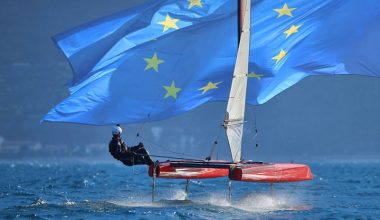
iFLY15 «Ultimate» Full carbon
ex tax, ex fact.
Designed in Germany Production in Western Europe.
11.2 sqm Decksweeper mainsail , Mylar / Pentex laminate,
7.5m aluminum mast , black anodized
7.5m Fiberfoam Carbon mast, as an option
XXL lightwind rig on 8.5m mast , as an option
A-class rig on 9m carbon mast , as an option
visible natural carbon: crossbeams, boom, foils, flight controls, tiller stick …
double layer wing trampoline: black mesh, red or black foot belts
iFLY15 hull colors 2024:
Ferrari – red Formula1 – yellow Brilliant – white Graphit – grey
Any other color is possible, on demand. With our professional art and paint team, we can realize any individual color and special designs, including sophisticated group or team designs.
options and accessories
Rig options.
Option: Fiberfoam Carbon mast, 7.5m, iFLY specific design, based on a-class design : 2.400 €
- by choosing this option, the iFLY serial mast (black anodized aluminum) is replaced by a high-tech Fiberfoam carbon mast. The carbon mast reduces weight by 4.7kg and increases sailing performance. However, the carbon mast is not recommended for double trapezing
Option: separable mast : 490 €
- The joint is made with a massive carbon sleeve inside. We did not observe any performance loss. The upper 2.25m of the mast can be taken off within seconds. No tools needed. It can be done without removing shrouds or diamonds and allows solving storage problems. Further this option can reduce shipping cost e.g. for overseas transport. Some sailors with height restrictions in the port or on their way to the water solve this by reducing thus the boat hight to 5.8m.
Option: Softwing rig for highest performance : 2.400 €
- iFLY is delivered with a state of the art decksweeper rig (like this year’s A-class sails). By choosing this option, the standard sail is replaced by the Heru Softwing rig: a three-dimensional structure bringing performance gains. Very different than a solid wing (as used e.g. in AC50 / C-Class) the softwing is not fragile and can be rolled and hoisted like a standard sail. It is watertight and thus floating, making righting up after a capsize even easier.
Mainsail halyard : 270 €
- iFLY comes with a push up main sail hoisting system (A-class style). Sailors who choose the standard decksweeper sail are free to choose the hoisting system they love more. For boats configured with the Softwing, halyard is strongly recommended.
auxiliary head sail for early take off in light winds. The revolutionary lightwind headsail. New developed sail configuration based on Genoa/Code0:
- The CodeF is a light wind head-sail used from 0 to 10 knots. This sail is used both, upwind and downwind, to get earlier on the foils. It is stowed away if wind picks up. CodeF is an option for super light wind. Usually You will sail the iFLY15 just with the mainsail.
CodeF preparation : 560 €
- riveted and screwed cleats, lamination in hull: bow tube. CodeF preparation is needed for CodeF sailing. The option should be ordered, in case CodeF kit will be added later.
CodeF premium option: surcharge : 580 €
- High-end version of CodeF, made from a kevlar fiber laminate
Second set of length adjustable trapeze, for double trapezing: surcharge : 220 € (per piece)
- Double trapezing is not recommended with carbon mast.
- Massive increase of righting moment allows performance gains of up to 25%, especially when full foiling upwind
additional Accessories:
Foot strap, length adjustable, including assembly (per piece) : 69 €
Telescopic carbon tiller stick, surcharge: 210 €
Hydrodynamic tips for rudders – to sail with removed horizontal wings in classic (non-foiling) mode with minimum drag: 67 € (per piece)
Hydrodynamic tips for daggerboards – to sail with removed horizontal wings in classic (non-foiling) mode with minimum drag: 86 € (per piece)
Big wheel beach trolley : 665 €
Cradles for road trailer, with universal mount – two versions available, flat bed or for round profile 50mm diameter: 215 € (per pice)
Foldable maintenance bench : 140 €
Spare parts kit : 240 €
Action cam stick : 280cm long carbon tube with special mount for filming e.g. from behind the boat: 150 €
Measuring gauge for precise assembly of mainfoil : 72 €
Measuring gauge for precise assembly of rudderfoil : 62 €
iFLY road trailer, Harbeck CS750, diagonal model, optional with aluminum storage box 285X85X45cm, lockable: price on demand
Shipping and assembly optionS
Pre-assembly in factory Portugal : 1.064 €
R oad transport within Europe: flat rate: 1.600 €
Shipping worldwide: individual offer
Complete assembly “ready to fly”, onsite, personal delivery 98 0 €
- including training on technical features, maintenance… (price for one day, plus travel cost)
Private coaching onsite, one day : 980 €
- only available together with “ready to fly” option)
Customization:
With our professional art and paint team, we can realize any individual color and special designs, including sophisticated group or team designs)
Individual color / any RAL color available: from/to : 600 € – 1.000 € (individual offer)
Individual design for hulls: from/to : 1.200 € – 3500 € (individual offer)
Special 2023 design: “Flying Tiger” , including individual choice of colors: 2.912 €
Individual design for sails, from/to : 600 € – 2400 € (individual offer)
(all prices are ex tax, ex factory Porto, Portugal. August 2023, subject to change without notice.) AGBs
Catamaran Europe Central
The iflysail team, is looking forward to your message.

COMMENTS
Hydrofoil catamarans can reach speeds of up to 40 knots (46 mph) or more, depending on the design and conditions. The foils on a hydrofoil catamaran can lift the hulls out of the water, reducing drag and allowing for a smoother and faster ride. Hydrofoil catamarans are used for various purposes, including racing, recreational sailing, and even ...
iFLY is a foiling catamaran that offers easy access to high speed and agile maneuverability with a sophisticated flight control system. It is a stable, modular and customizable sailboat that can be sailed alone or in pairs, and reaches up to 30 knots in good conditions.
A much smaller trim foil (or foils) is then located near the stern of the catamaran and again, this/these can be set up at a fixed angle or can be adjustable to vary the trim angle of the boat and the angle of attack of a fixed main foil. Generally this system is designed to carry approximately half the displacement of the vessel at maximum speed.
The Aquila 36 Sport Hydro Glide is a power catamaran with hydrofoils that lift the hulls out of the water for better performance and fuel economy. Learn how hydrofoils work, how they compare to other boats and how they improve the ride, acceleration and range of the Aquila 36 Sport.
Morrelli & Melvin have been working on power catamaran hydrofoil technology since the 1990s, constantly developing, testing, and improving on the current state of the art. The company has created approximately 100 foil-assisted power catamarans, and numerous fully foiling sailboats and participated in the last four America's Cup events as ...
Hydrofoils are underwater wings that lift a boat while moving through the water, reducing weight and drag. Learn how they work, how they benefit electric-powered and gas-powered boats, and how to install them.
Learn about the history and design of hydrofoils, the wings that enable boats to fly above the water. Discover 10 amazing foiling boats, from record-breaking multihulls to radical dinghies, and see them in action.
Watch how the athletes of SailGP race with razor-sharp hydrofoil catamarans that can reach speeds of 60 miles an hour. Learn about the technology, the crew positions, the data and the future of ...
Foiling is the use of hydrofoils attached to the hull of fast boats, which provides additional lift and efficiency at planing speeds. Learn how foils work, their history, benefits and challenges, and see examples of foiling powerboats.
We can recommend the best iFLY setup and accessories for your boat. A great number of innovations all over the catamaran and the perfect match of all components allow controlled high-speed foiling experience. iFLY15 is full of innovations, e.g. in hull design, hydrofoils, rudders, automatic flight control system, two-layer wing trampoline, high ...
Join boats.com and Marilyn DeMartini in Cape Canaveral Florida along with Tarpon River Boatworks CEO Todd Meyer for a full walkthrough video tour and review ...
Add a hydrofoil, and suddenly you add a new dimension. These boards take lots of skill and practice to master, but the ride is said to be much smoother and even faster than a conventional kiteboard. Cost starts at around $1,000. ... The fastest nonfoiling catamarans in previous races could barely reach 35 knots, while the 2017 foiling cats hit ...
The Insetta 35IFC is a center console sport fishing catamaran with hydrofoil-assisted design for unmatched performance, range, and efficiency. Learn about its features, specifications, and FAQs on the official website of Insetta Boatworks.
Learn about the different shapes, hulls and foils of foiling catamarans, which can sail or fly on the water at high speeds. Find out the top manufacturers, prices and examples of these exciting boats.
Learn about the history, types and benefits of foiling and hydrofoiling in sailing and other watersports. Find out the latest news, tips and stories on foiling boats, yachts, dinghies, windsurfers ...
UFO is a modern hydrofoiling boat that allows anyone to fly through the air with a simple rig and retractable foils. It is compatible, rewarding and fun for all skill levels, ages and wind conditions, and can foil on all points of sail.
This web page showcases six different types of hydrofoil boats, including electric, foiling RIBs, and superyacht tenders. It does not mention the Thunderstreak hydrofoil, which is a different model from the Candela C-8 featured in the article.
Using hydrofoil supported planing catamaran technology, the LINX design ensures exceptional stability, fuel efficiency, and a remarkably smooth, dry ride even in challenging conditions. The LINX is the only superyacht tender built on the Balearic island of Mallorca. BEACH LANDING.
Sunreef Yachts Presents the World First Hydrofoil System for Luxury Open Catamarans. September 15, 2014. Catamarans offer several specific features that make them a perfect alternative for traditional yachts, e.g. a bigger living space (sometimes even twice as big as on a single-hull vessel), excellent stability and a very long cruising range ...
The Flying Phantom is a racing catamaran that uses two J-shaped wings to rise out of the water and reduce drag and waves. It can reach speeds of up to 33 knots and offers a smooth and silent ride.
Learn about sailing hydrofoils, which are sailboats with wing-like foils that lift the hull out of the water for speed and performance. Find out how the International Moth class, the first and most widespread foiling class, uses "T" foils on the centerboard and rudder, and how other classes such as Waszp and AC75 use different types of foils.
There are V-shape foil systems, flat type foils and deeply submerged foils; mostly all foils come in pairs for longitudinal stability. The fundamental design concept behind all hydrofoils is the idea that the foil must carry the full load weight of the craft, driving the hull out of the water and letting the foil carry all the weight with the hull being carried as deadweight, which is only ...
iFLY15 is a high-performance foiling sailboat with carbon mast, softwing rig, codeF sail and other options. See the price list for decksweeper mainsail, hull colors, trapeze, foils, covers, trailer and more.